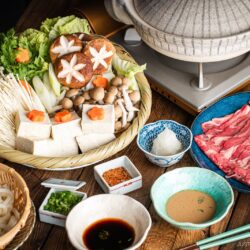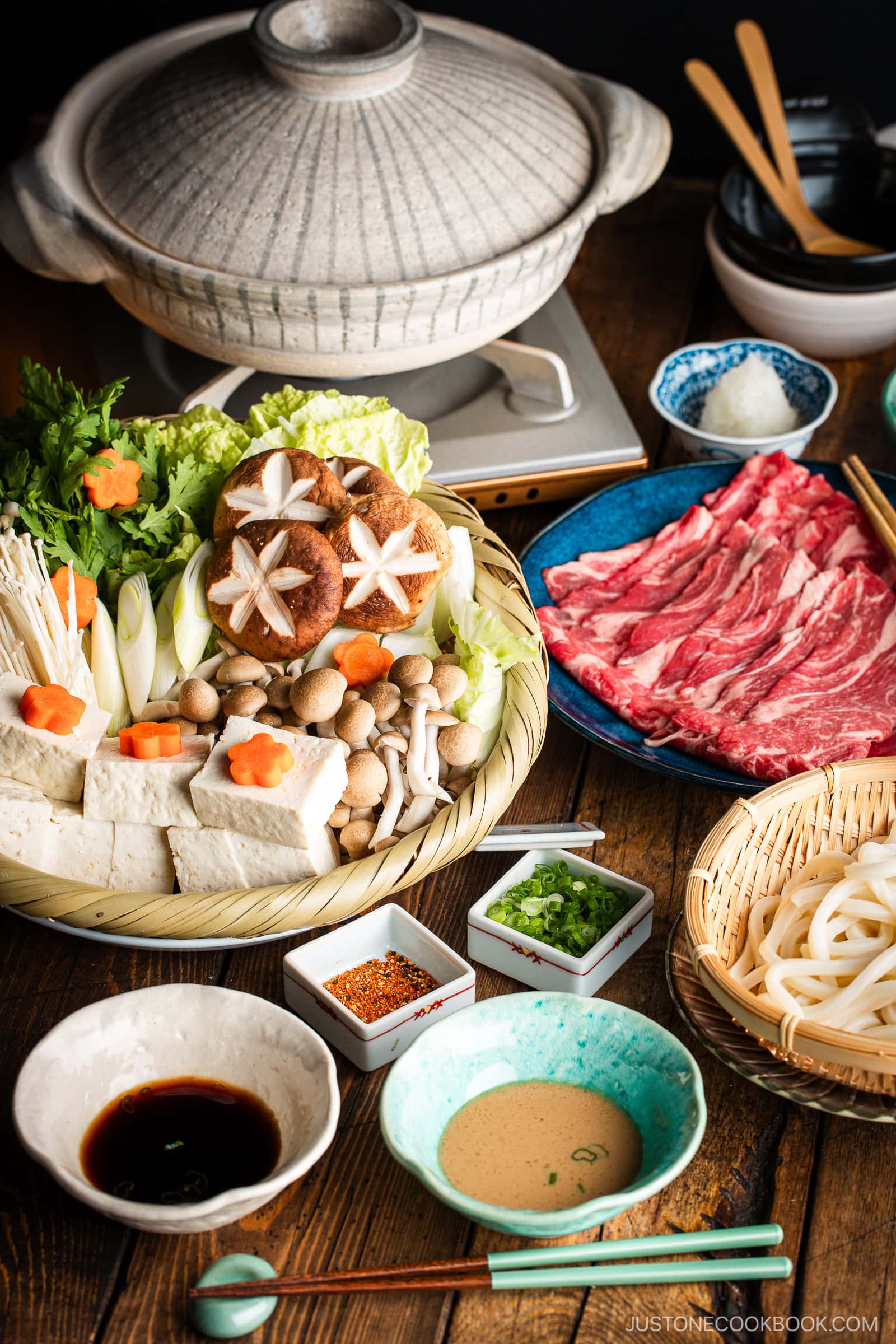
Hot pot is the ultimate cold-weather comfort food. It’s a lively, communal meal that everyone enjoys cooking together at the table. While we have many hot pot recipes in Japan, I suggest starting with Shabu Shabu (しゃぶしゃぶ). I’ll guide you through the easy prep and cooking steps so you can share this dish at home with your family and friends.
If you’re craving more hot pot recipes, try my Yosenabe, Sukiyaki, and Mille-Feuille Nabe next!
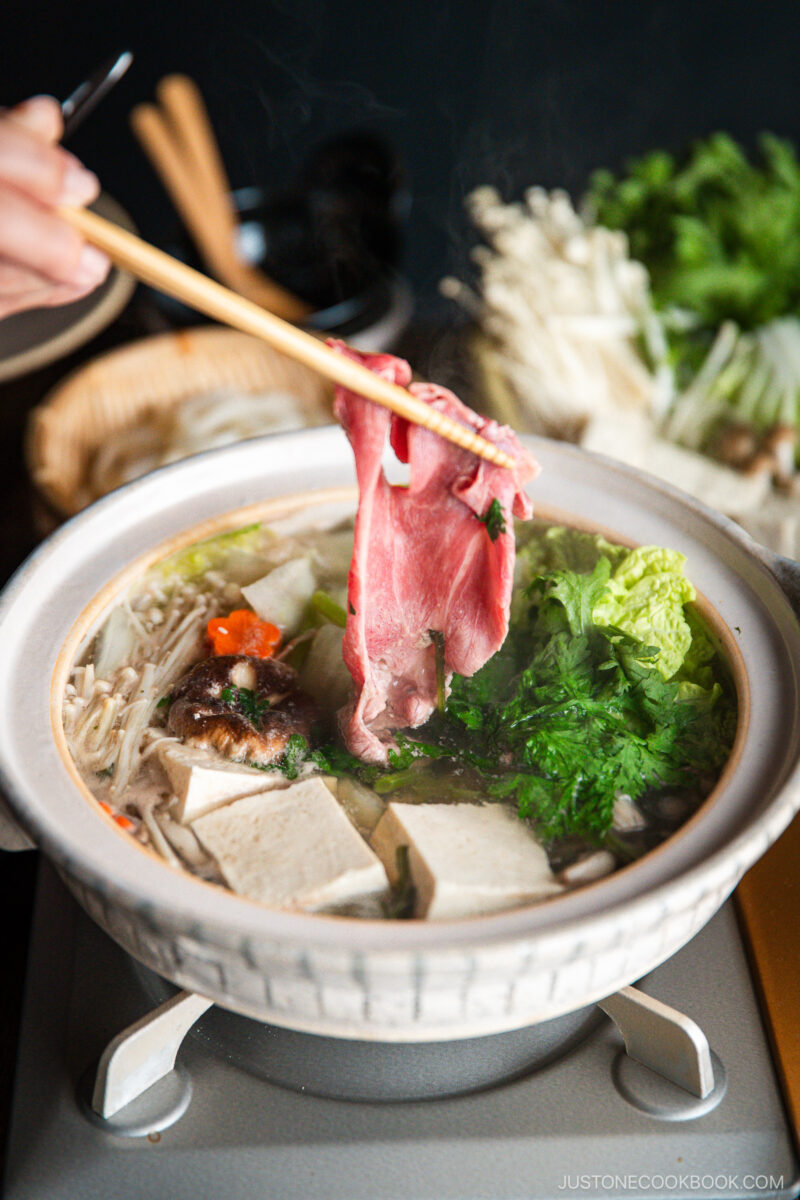
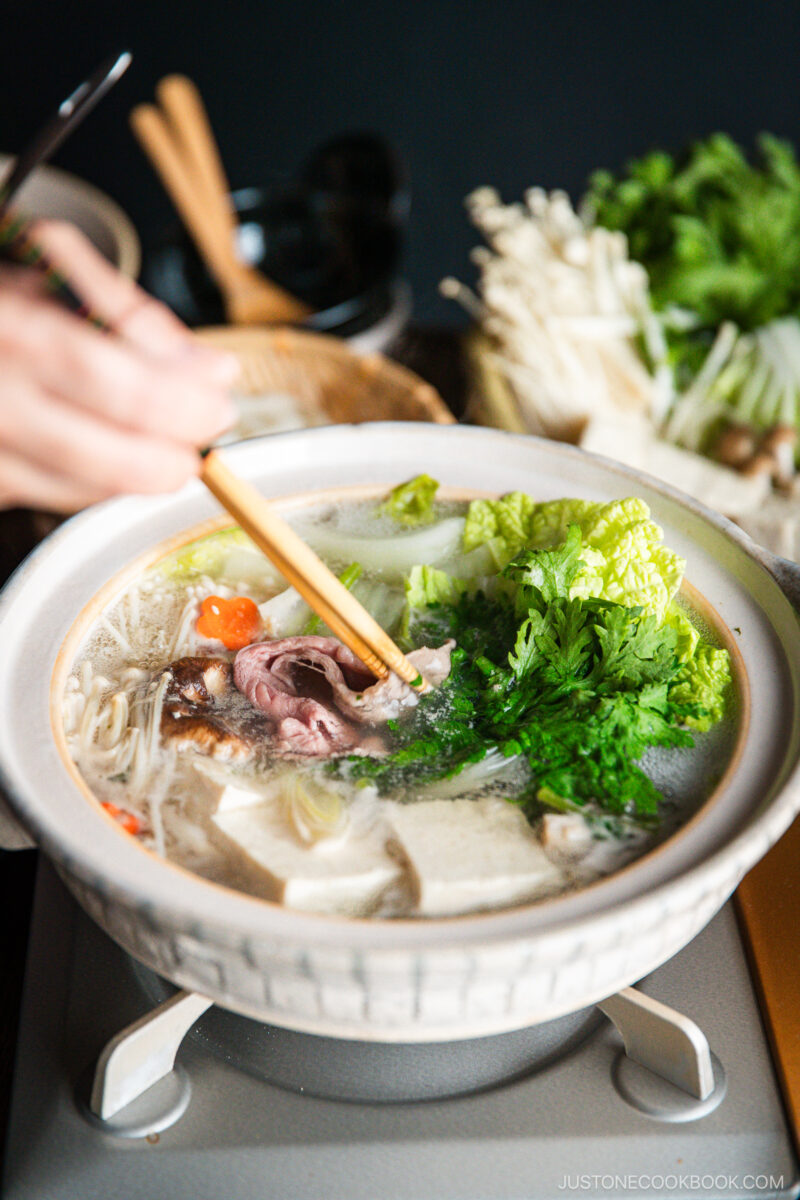
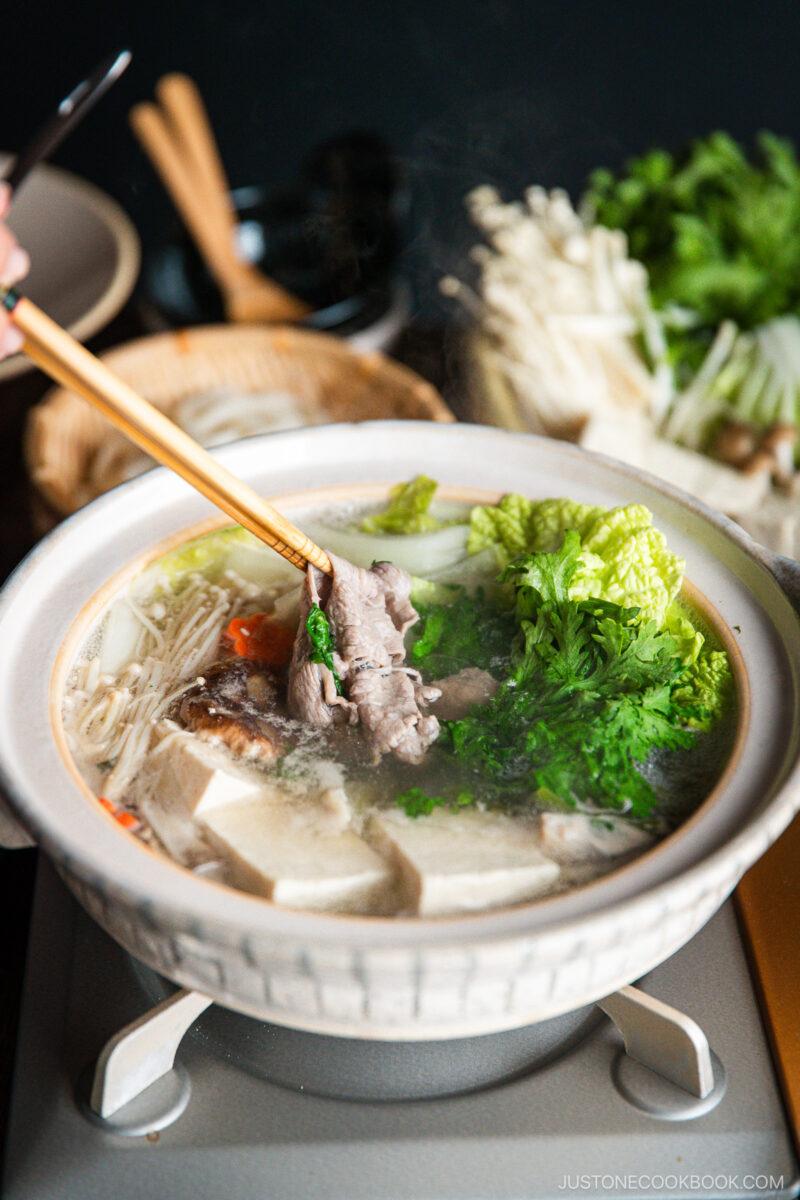
What is Shabu Shabu?
Shabu shabu is Japanese onomatopoeia for the “swish-swish” sound of cooking the meat and vegetables in the light dashi broth. It’s one of Japan’s most popular hot pot dishes where the diners cook the meal together at the table in a communal Japanese clay pot (donabe). While hot pot may have originated in Inner Mongolia and China, this classic Japanese variation was invented in the early 1950s at Suehiro restaurant in Osaka.
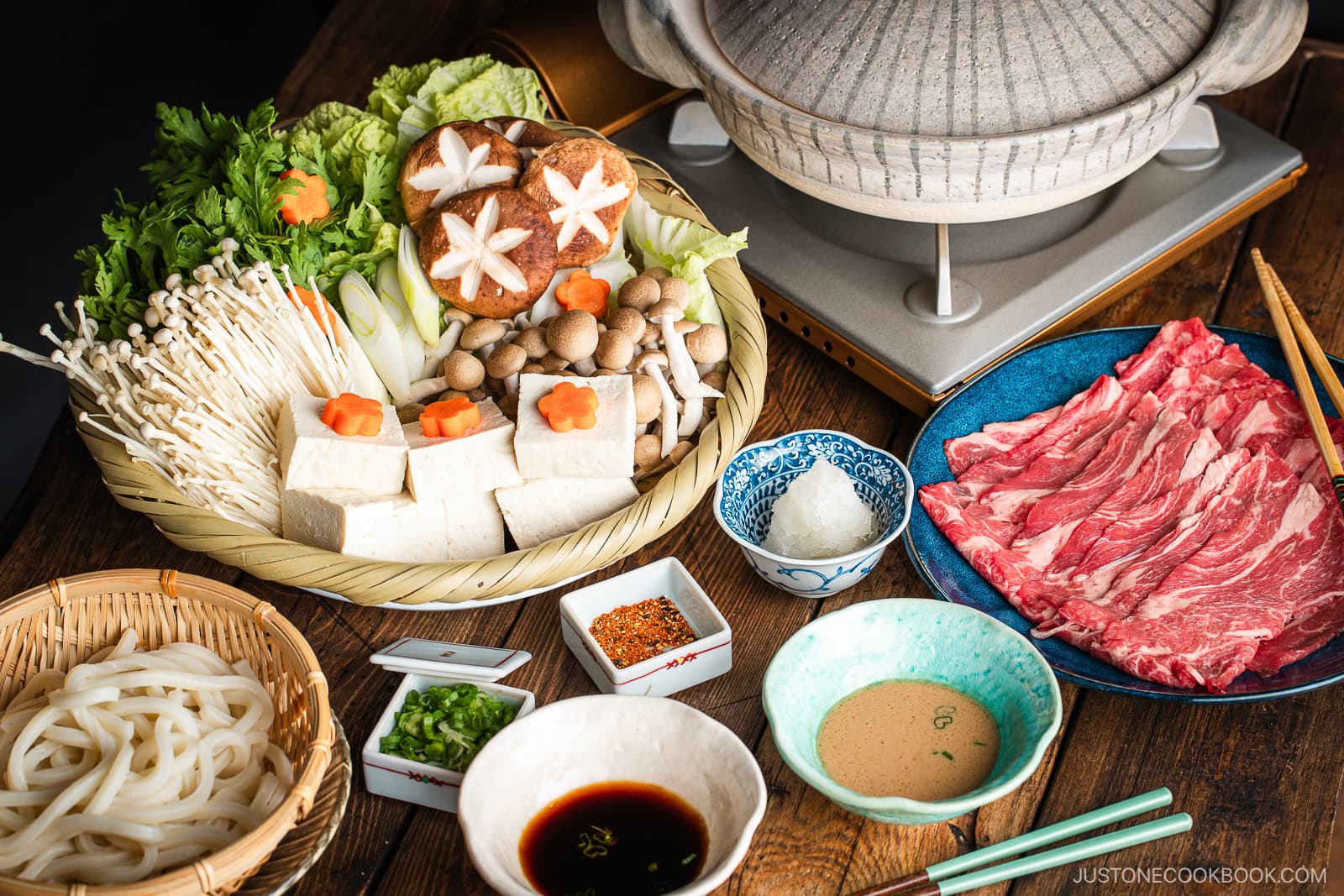
Ingredients for Shabu Shabu
- Kombu (dried kelp) and water
- Thinly sliced beef (chuck or ribeye; well marbled)
- Medium-firm tofu
- Shiitake mushrooms, enoki mushrooms, and shimeji mushrooms
- Napa cabbage
- Shungiku (chrysanthemum greens)
- Tokyo negi (long green onion) – or use the white part of a leek or green onions
- Carrot
- Udon noodles – frozen or parboiled
- Sesame sauce and ponzu sauce – for dipping
- Grated daikon radish, chopped green onions/scallions, and shichimi togarashi (Japanese seven spice) – for the sauce condiments
Find the printable recipe with measurements below.
Jump to RecipeSubstitutions
- Kombu dashi: We always use soup stock made with dried kelp for this dish. Simply drop a piece of kombu in a pot of water and let it steep. That’s it! If you can’t find kombu, you can use another dashi.
- Thinly-sliced beef or pork: Select well-marbled meat labeled “for shabu shabu” from a Japanese or Korean grocery store. If you can’t find it, you can slice good-quality chuck or rib eye yourself using my How to Slice Meat Thinly tutorial.
- Dipping sauces: You can find bottled ponzu (citrus soy sauce) and creamy sesame sauce on Amazon or at an Asian/Japanese supermarket. I like the fresh taste of my Homemade Ponzu Sauce and Homemade Sesame Sauce recipes, so please give them a try!
- Shungiku and Tokyo negi: Try a Japanese or Asian grocery store for harder-to-find produce like shungiku, long green onion, and Japanese mushrooms. Or, you can swap your choice of leafy greens and vegetables.
Key Kitchen Tools or Key Equipment
- portable gas stove and gas canister
- donabe, heavy-bottomed pot, or electric hot pot
- long cooking chopsticks
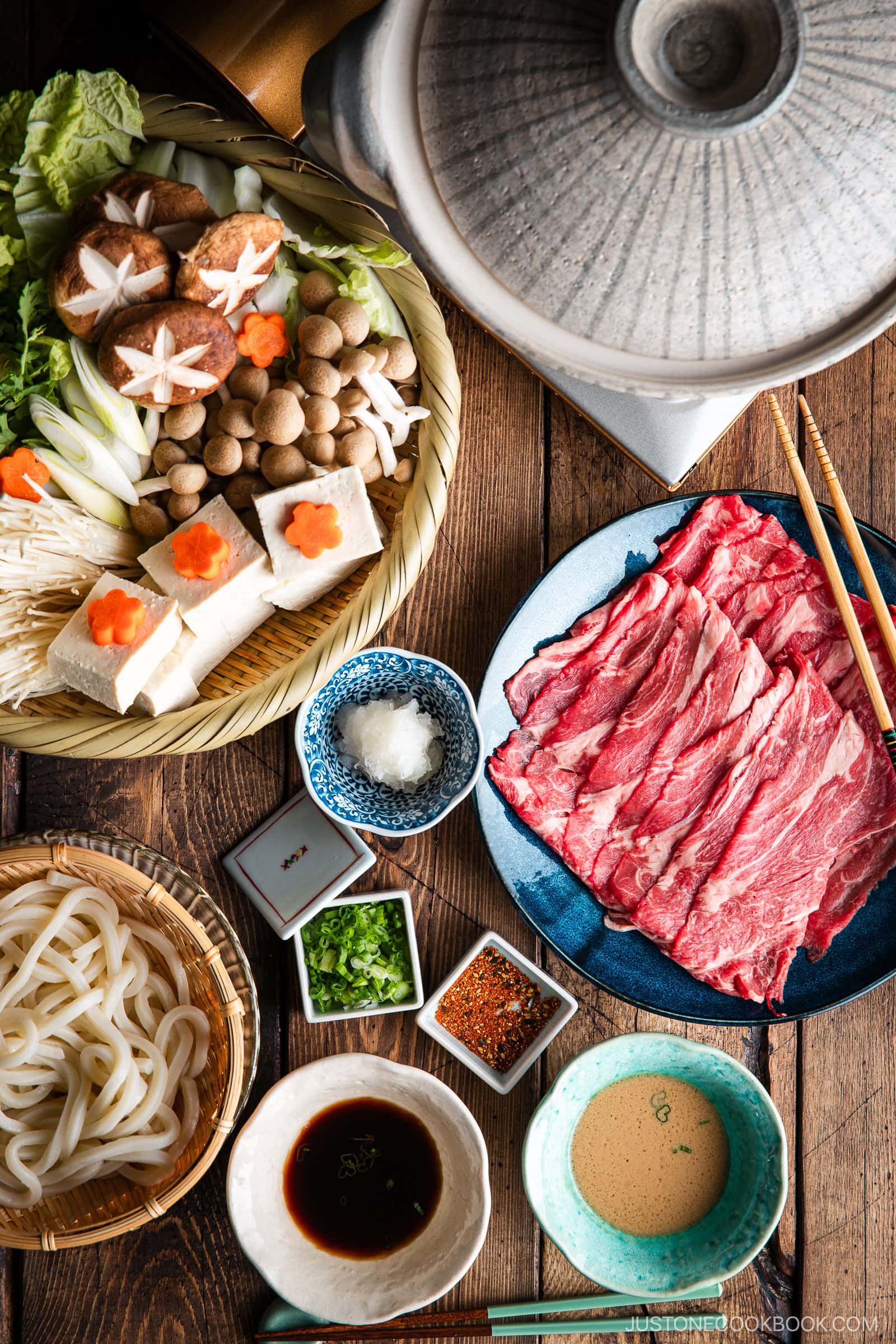
How to Make Shabu Shabu
Preparation
Step 1 – Prepare the broth and reheat the udon. Soak the kombu and water in a donabe for at least 30 minutes. Meanwhile, if you’re going to serve udon noodles at the end of your hot pot meal, reheat the frozen udon in boiling water. Drain and set aside on a plate.
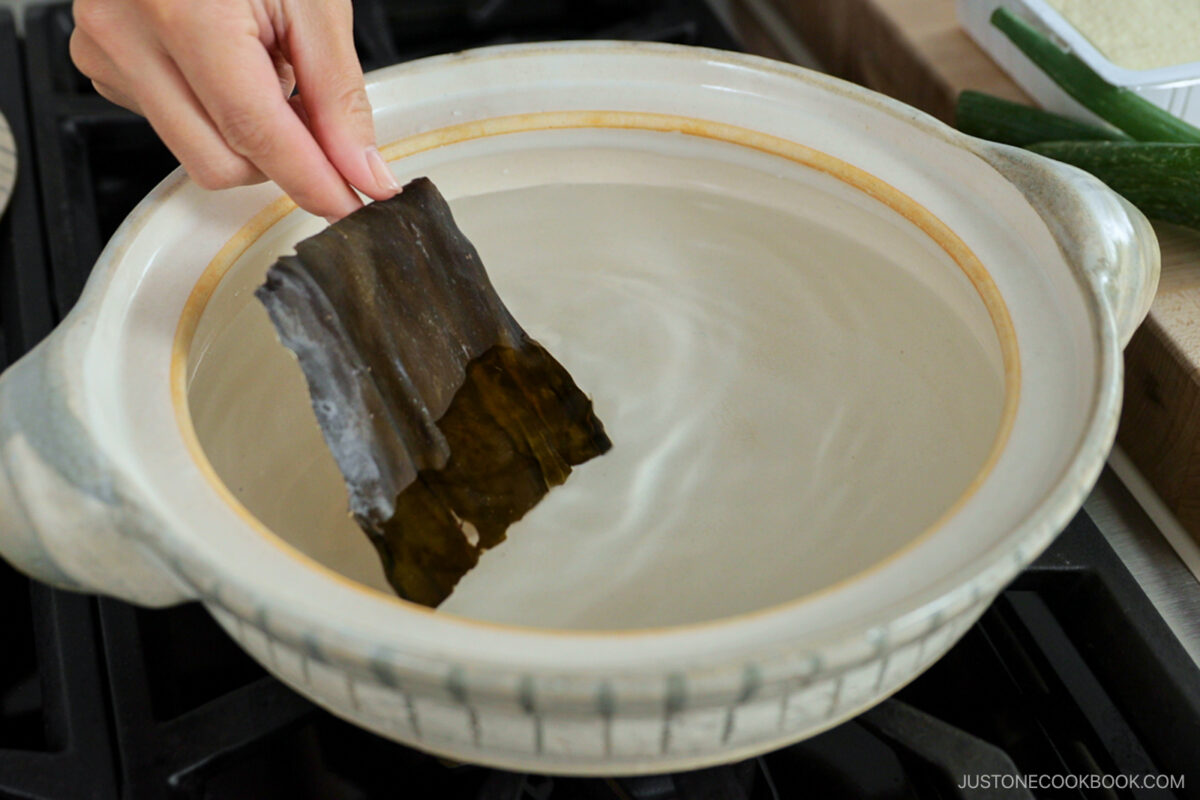
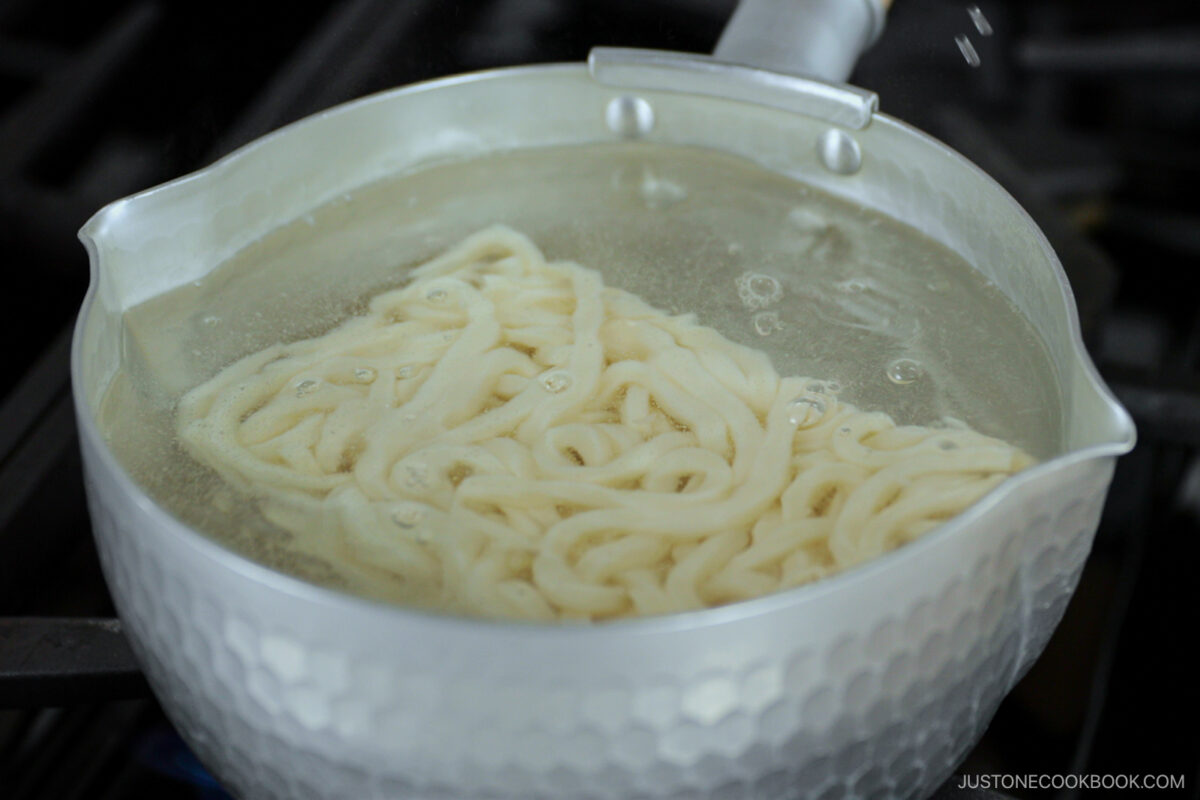
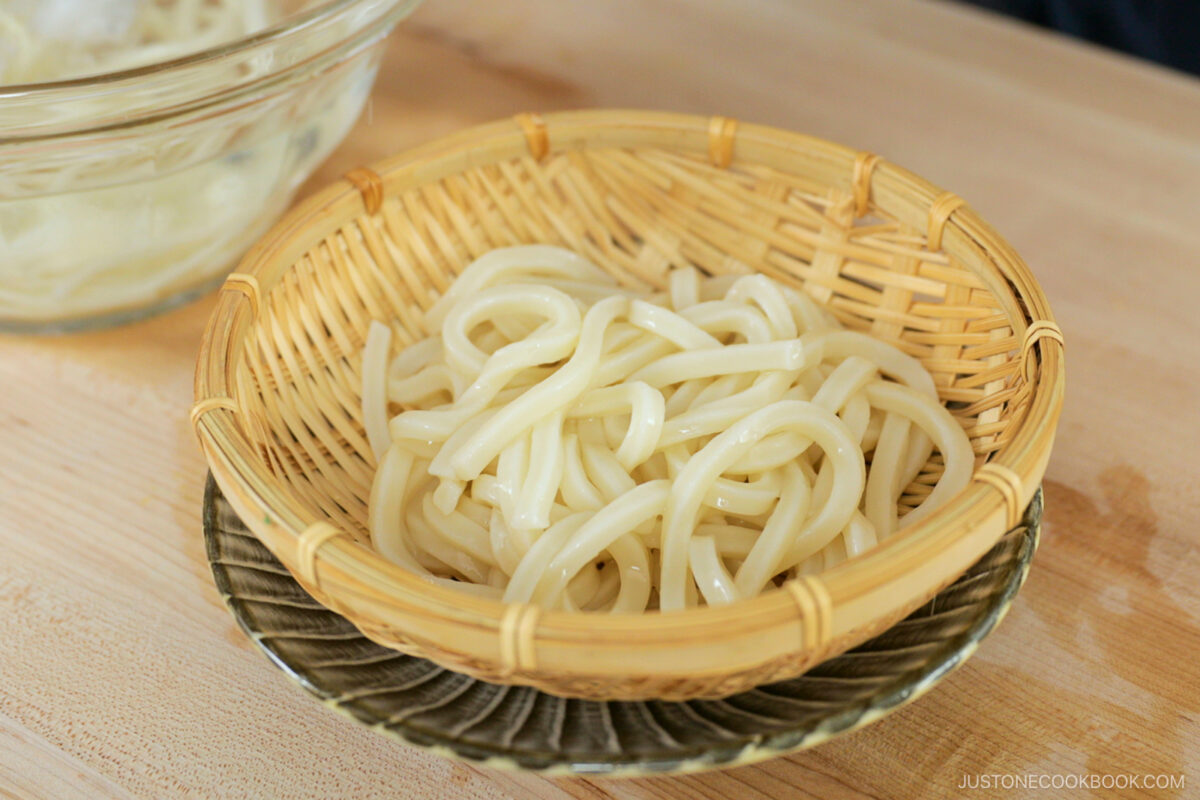
Step 2 – Cut the vegetables. Cut the napa cabbage, shungiku, carrots, and Tokyo negi into bite-sized pieces. Grate the daikon and chop the green onion and place in small bowls.
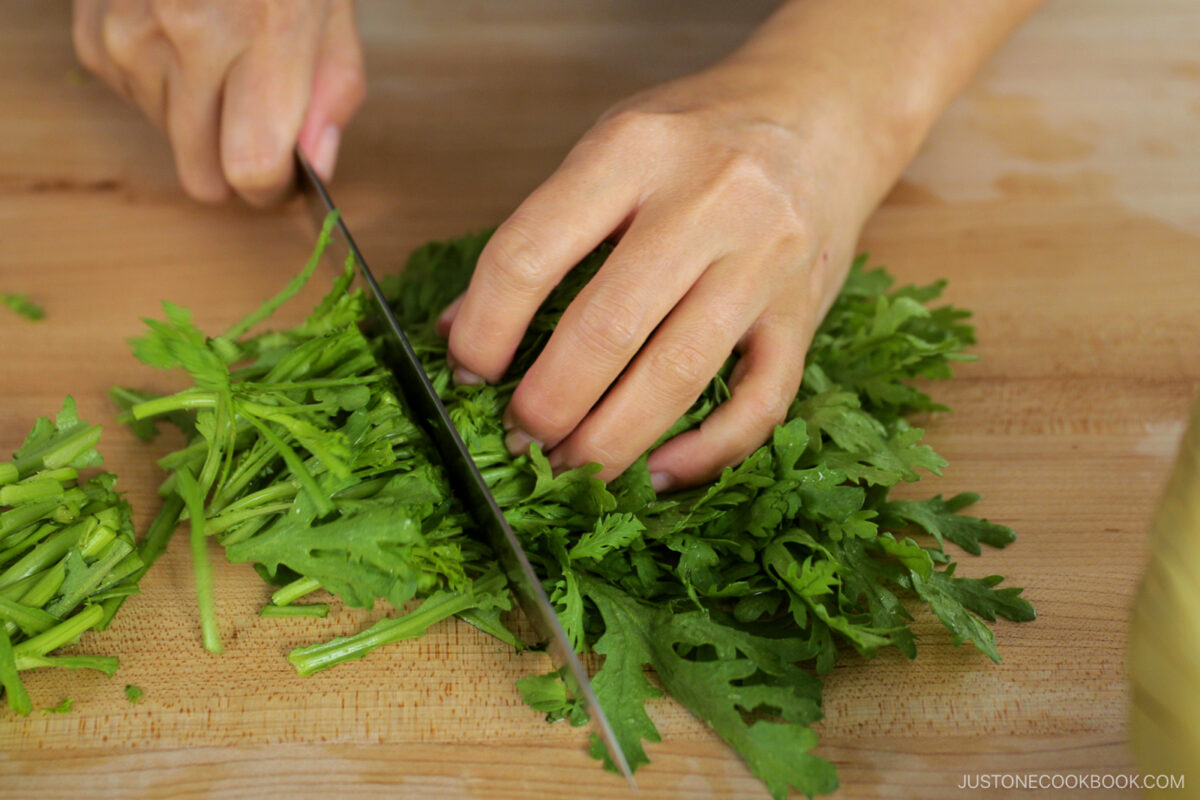
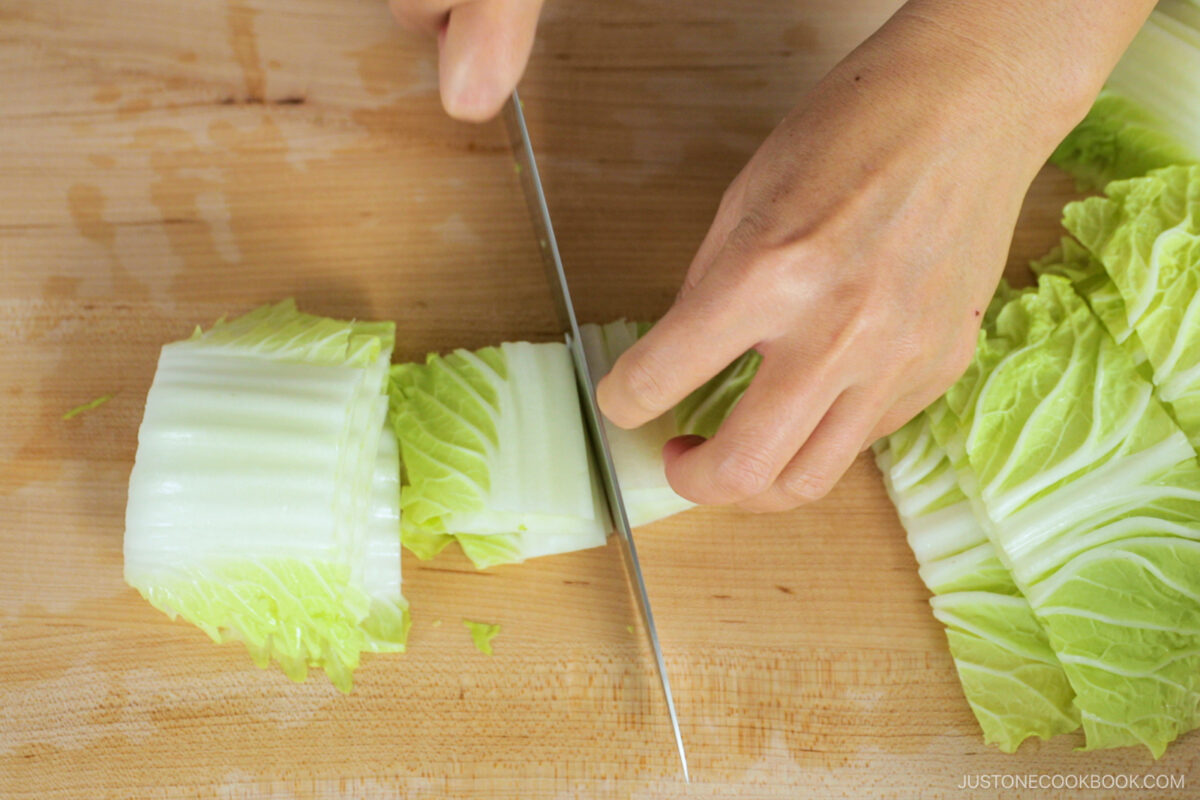
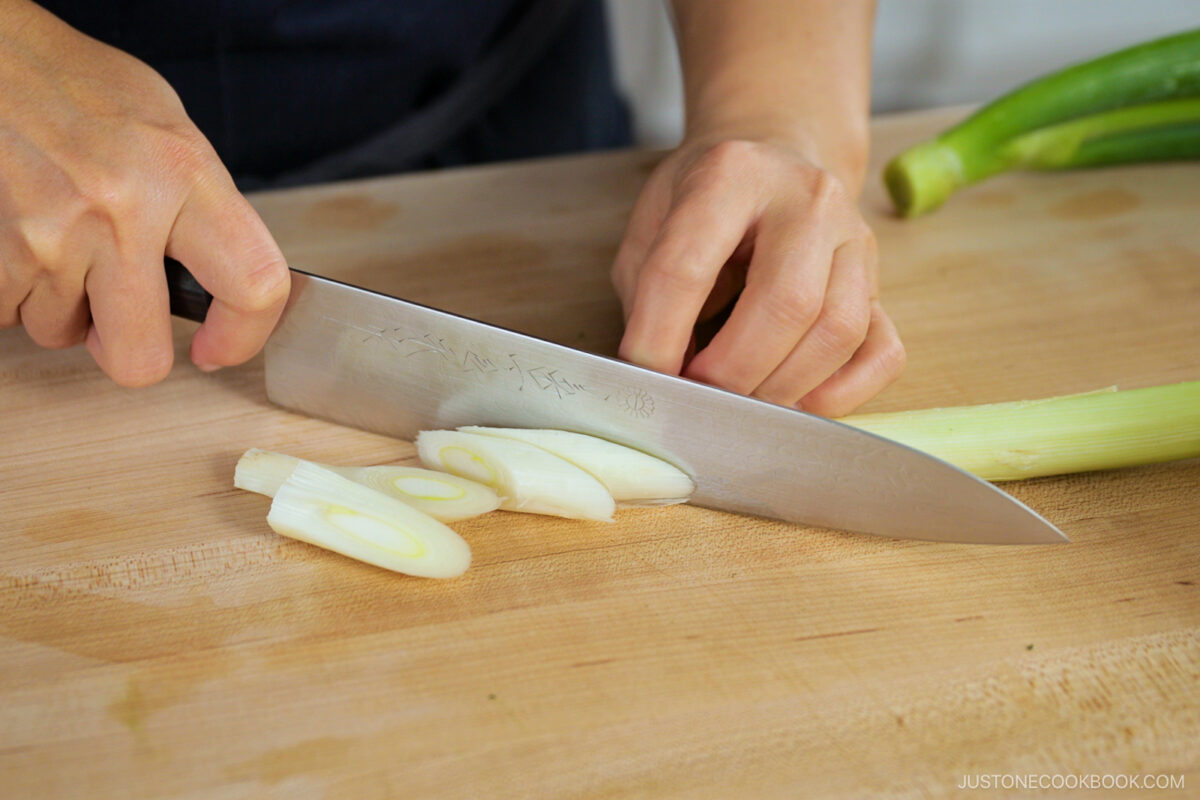
Step 3 – Prep the mushrooms and tofu. Break the shimeji and enoki into smaller chunks and cut the shiitake stems. Cut the tofu.
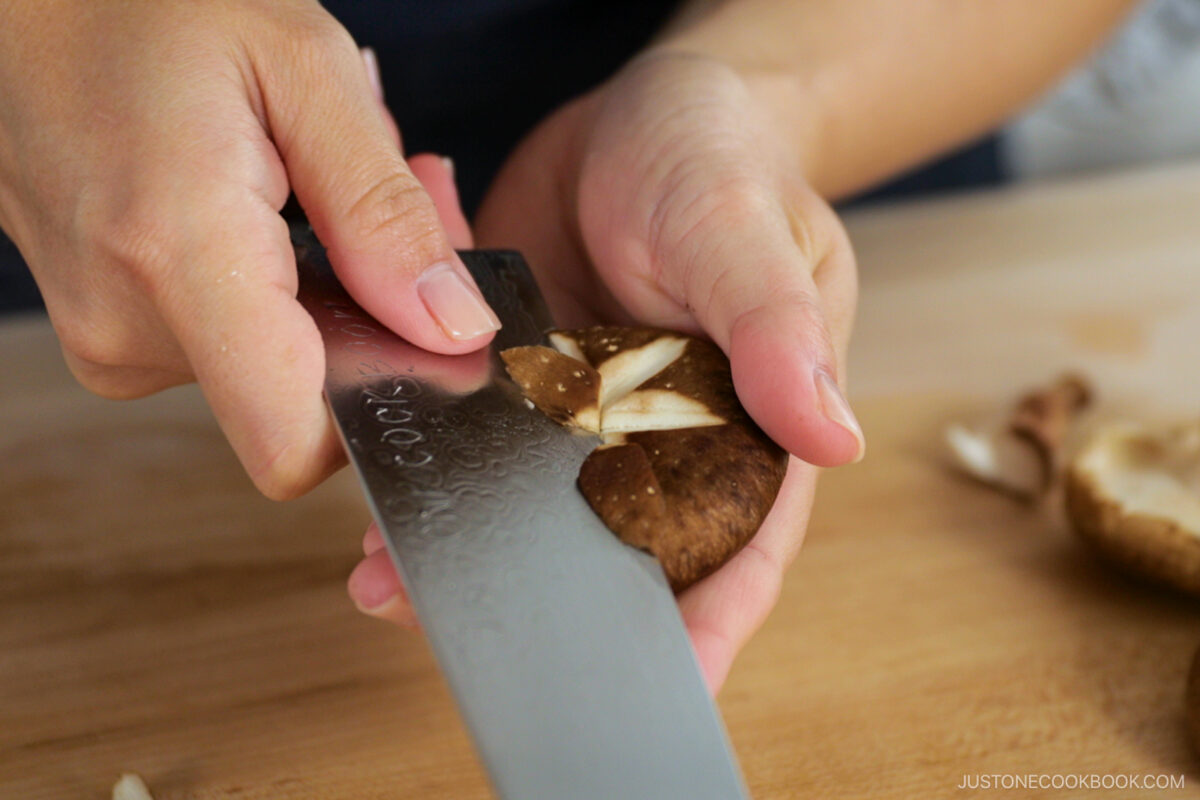
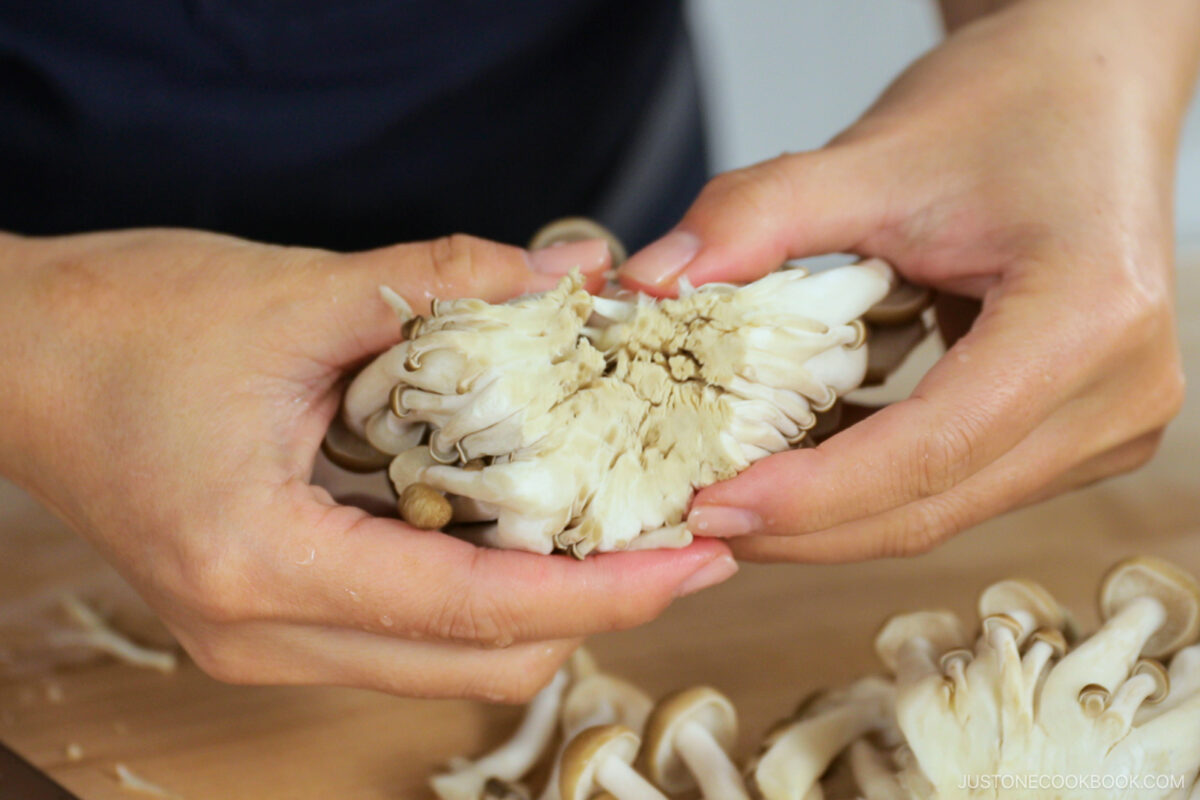
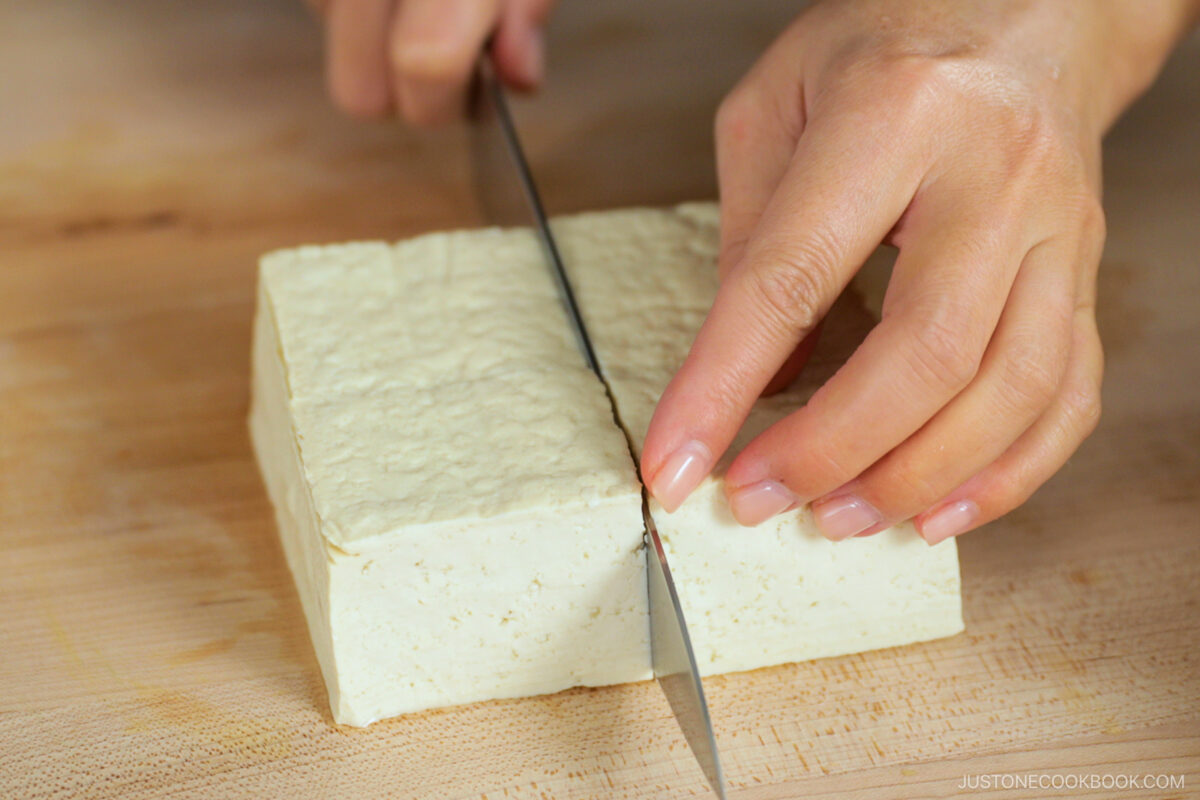
Step 4 – Arrange the platters. Set the tofu, mushrooms and vegetables on one plate and the beef on another. Place them on the table along with the donabe and portable burner.
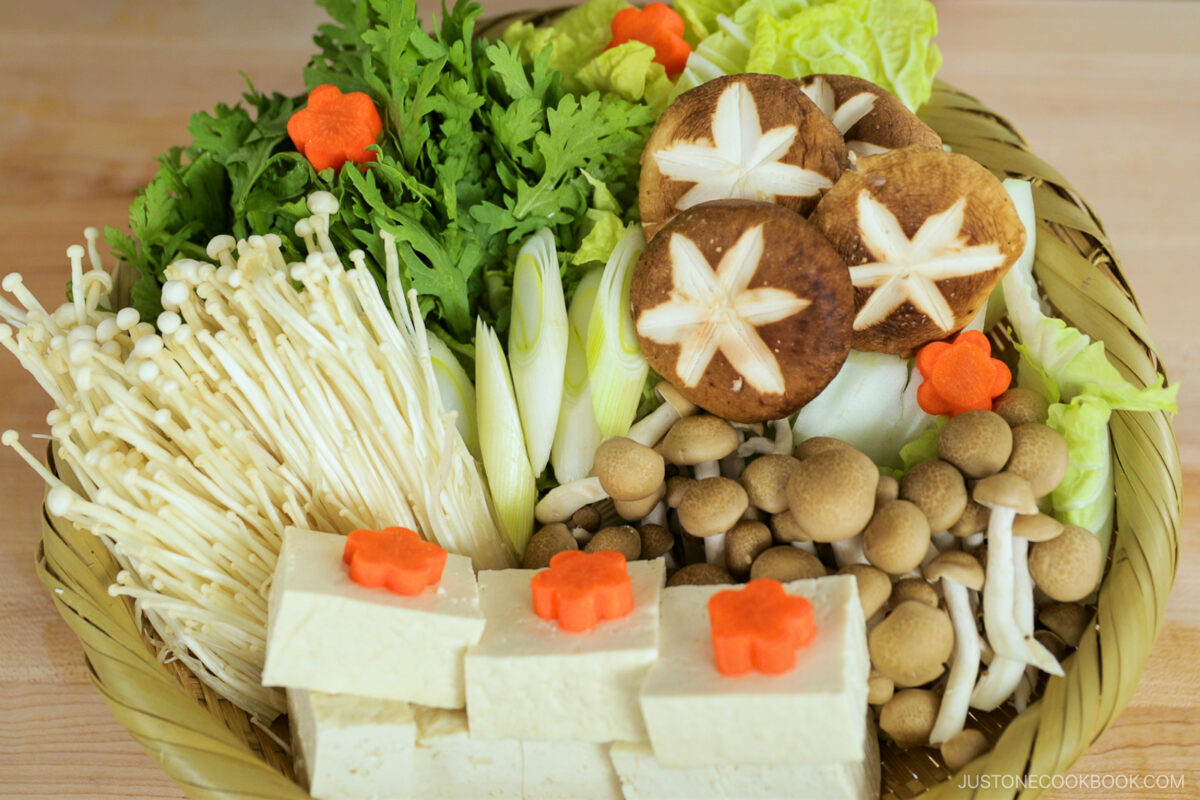
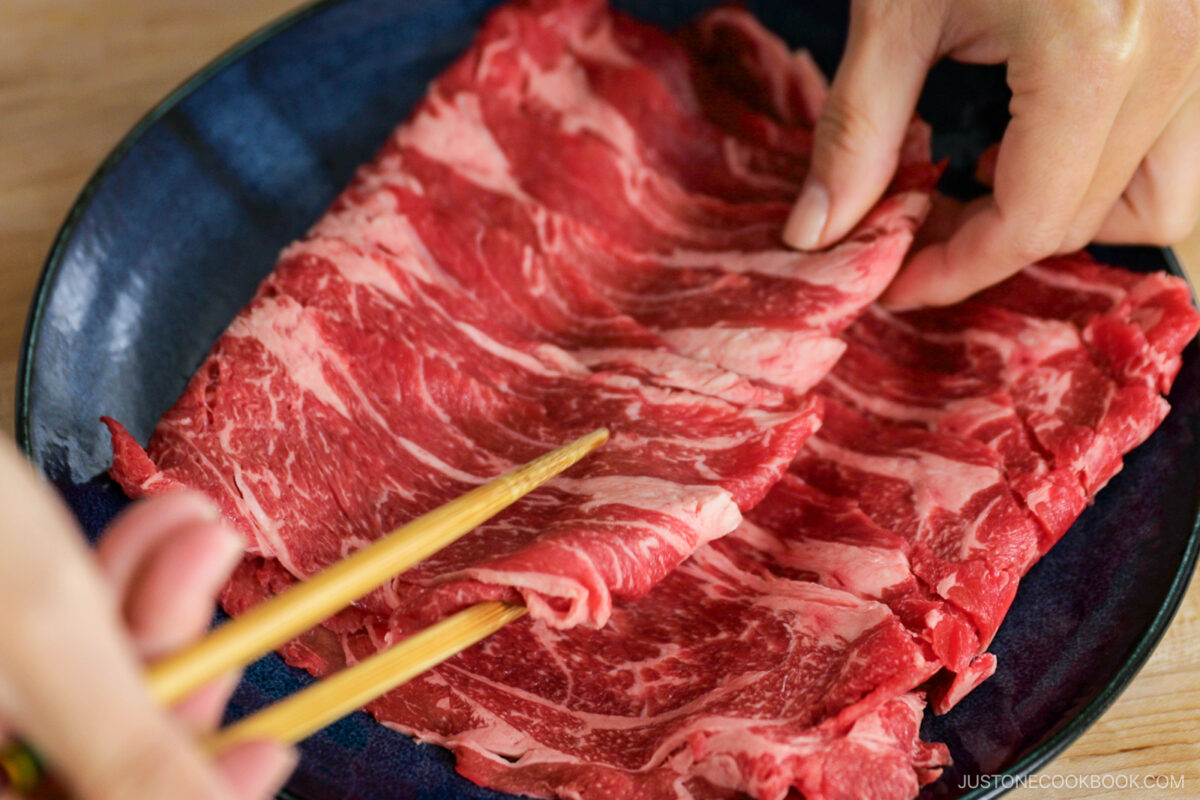
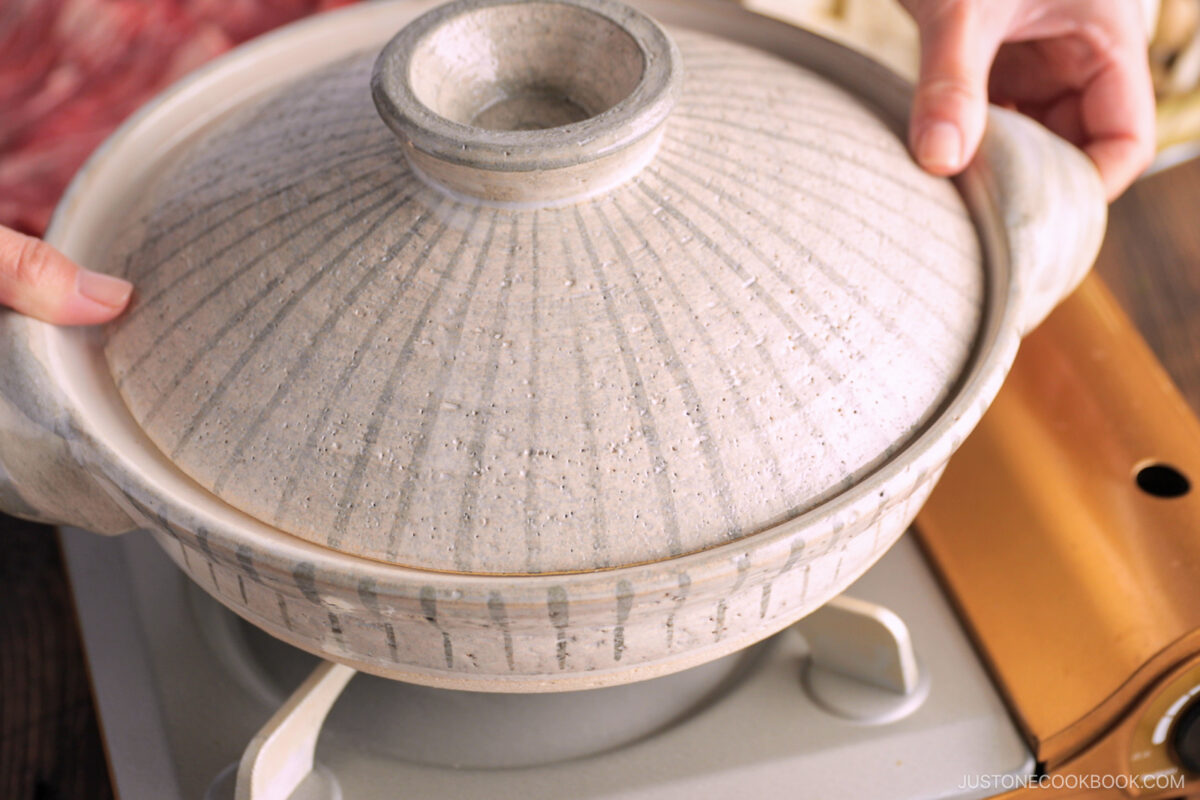
Cooking
Step 5 – Cook the dense vegetables. Bring the dashi to a boil over medium heat; remove the kombu just before boiling. Add the tofu, thick parts of the napa cabbage and shungiku, carrots, and some mushrooms. Simmer until cooked.
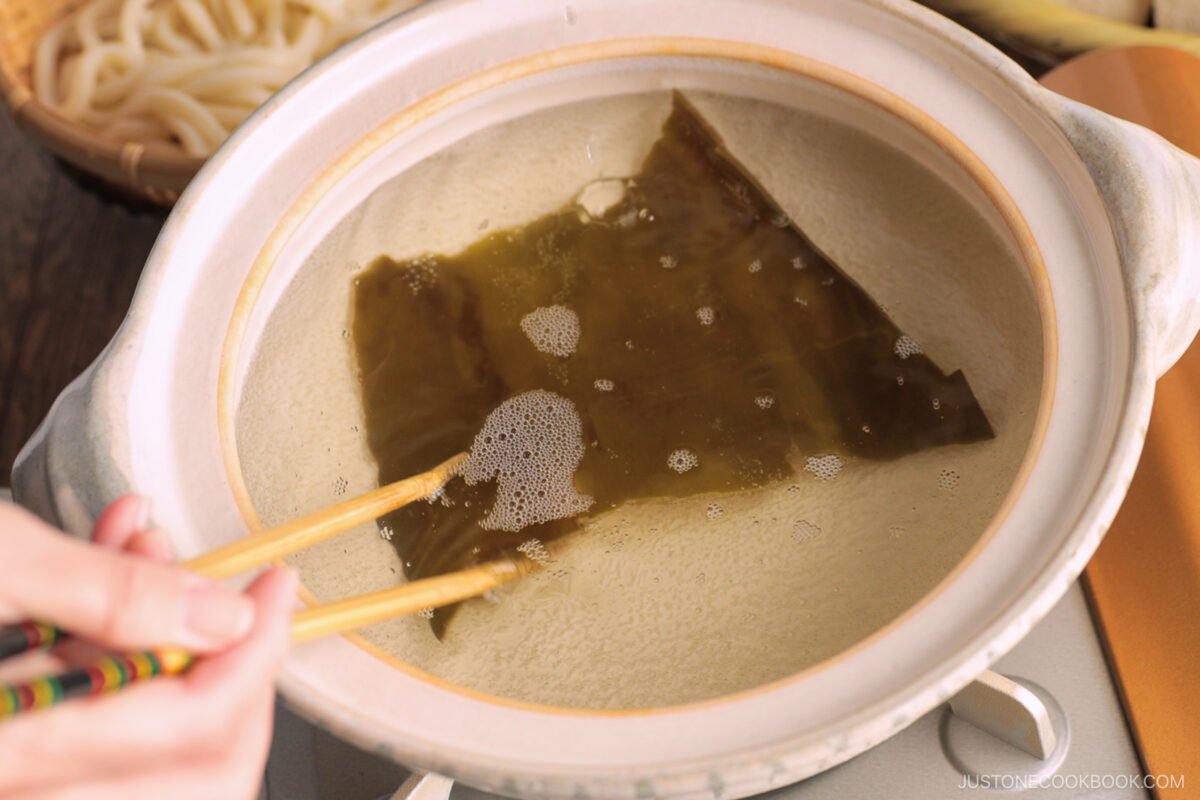
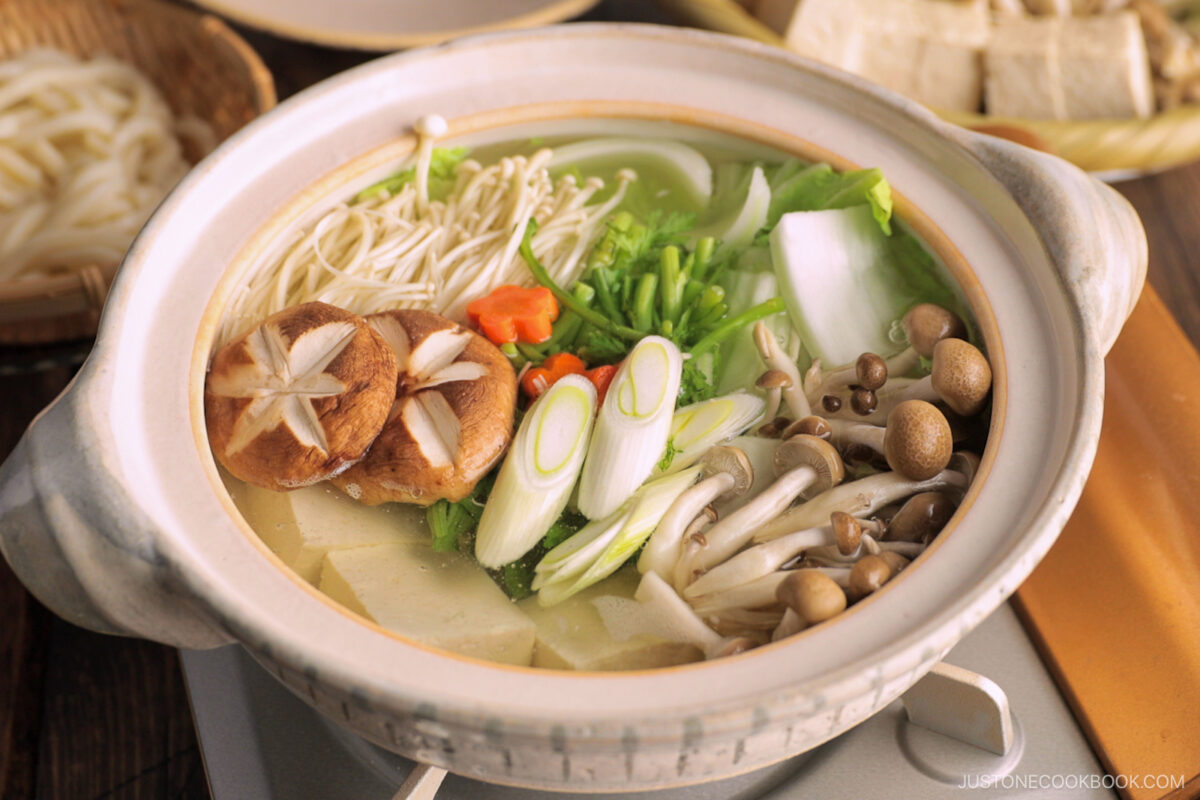
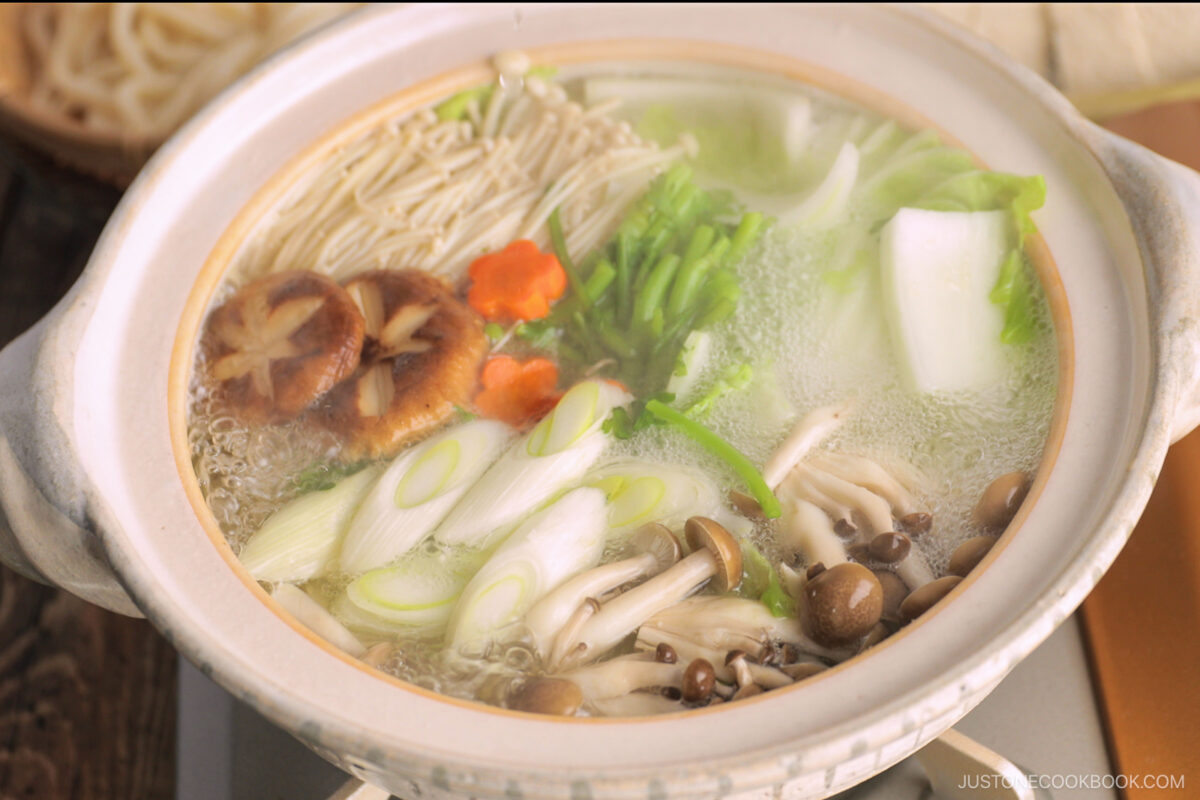
Step 6 – Cook the meat. Briefly swish the beef in the broth until no longer pink.
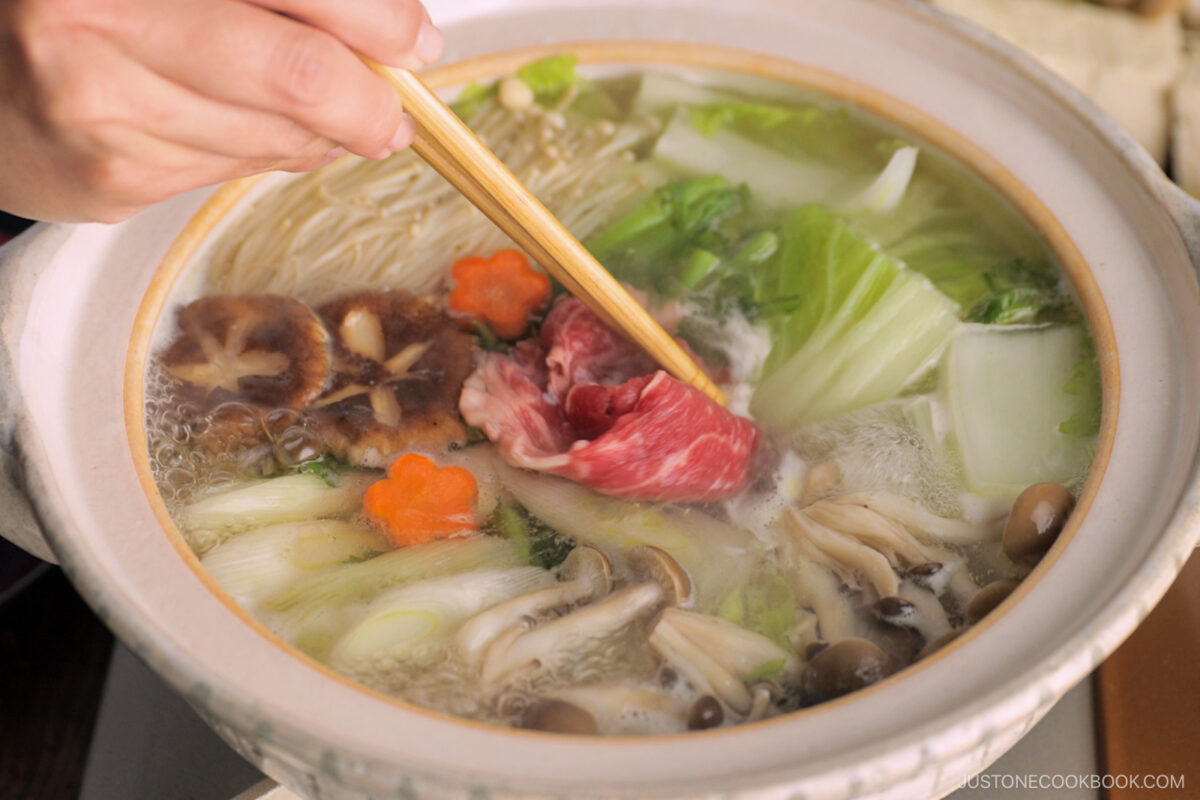
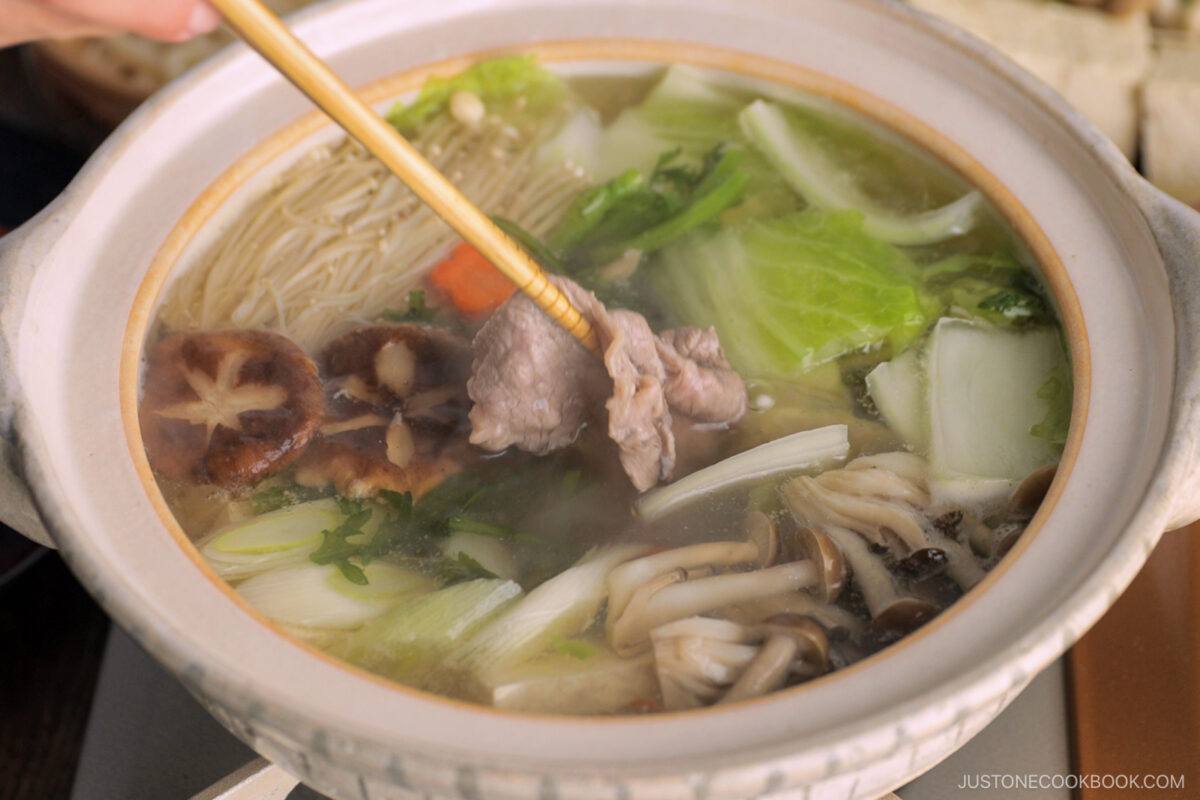
Step 7 – Serve and keep cooking. Self-serve the cooked food as it’s ready and dip in sauces to enjoy.
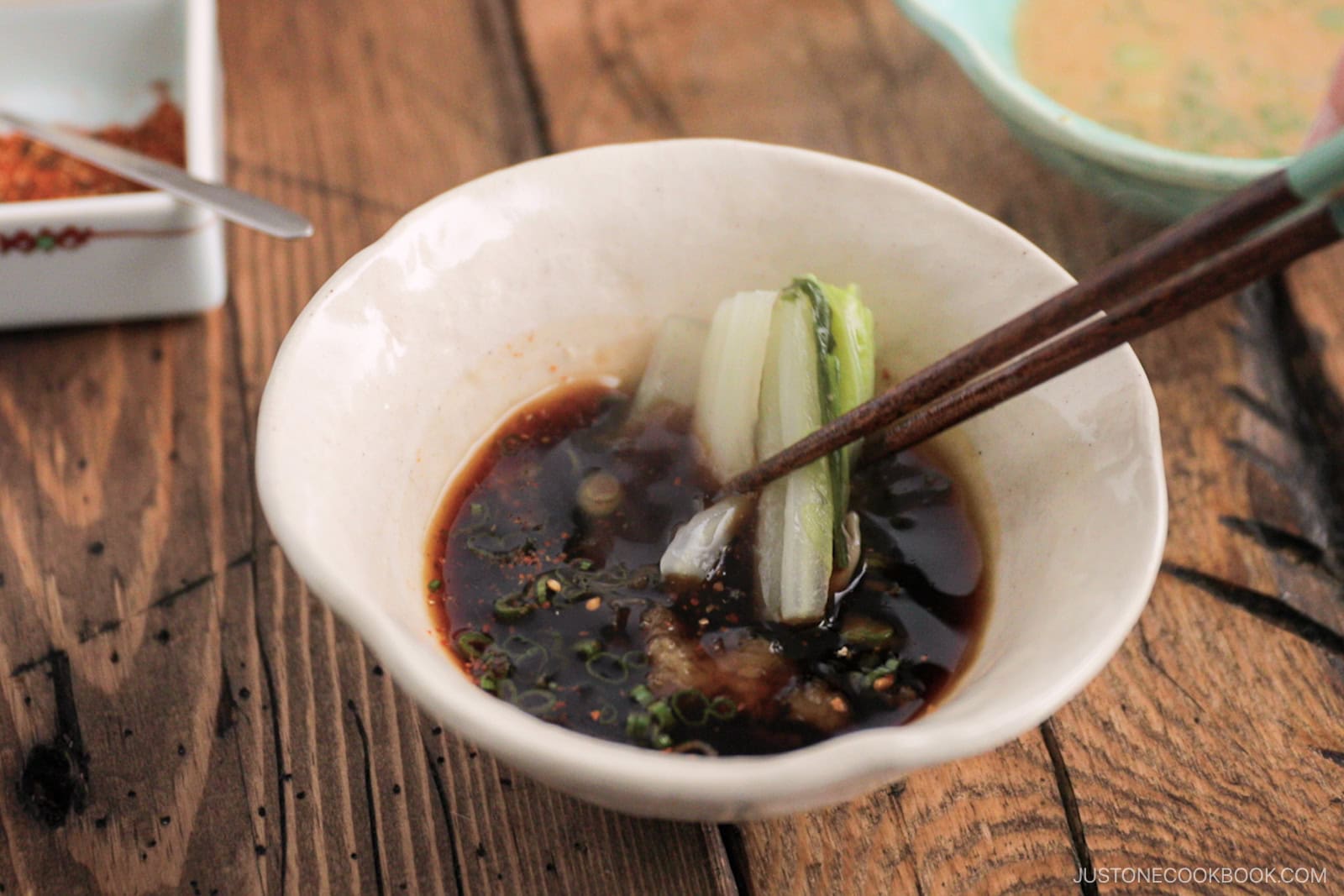
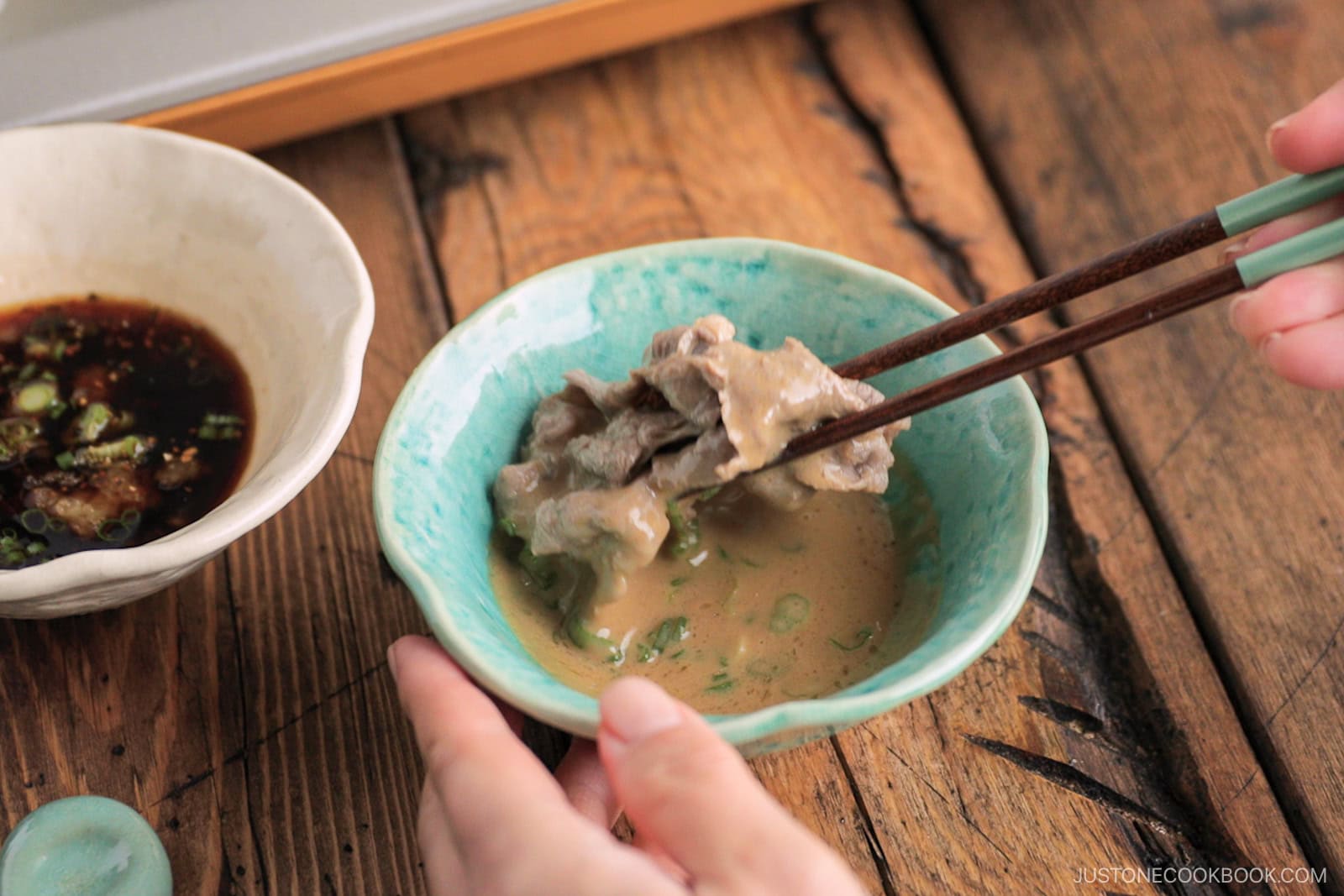
Step 8 – Skim and add the leafy vegetables. Cook until tender and serve. Cook the meat as you’re ready to eat, and enjoy the other ingredients while restocking the pot along the way.
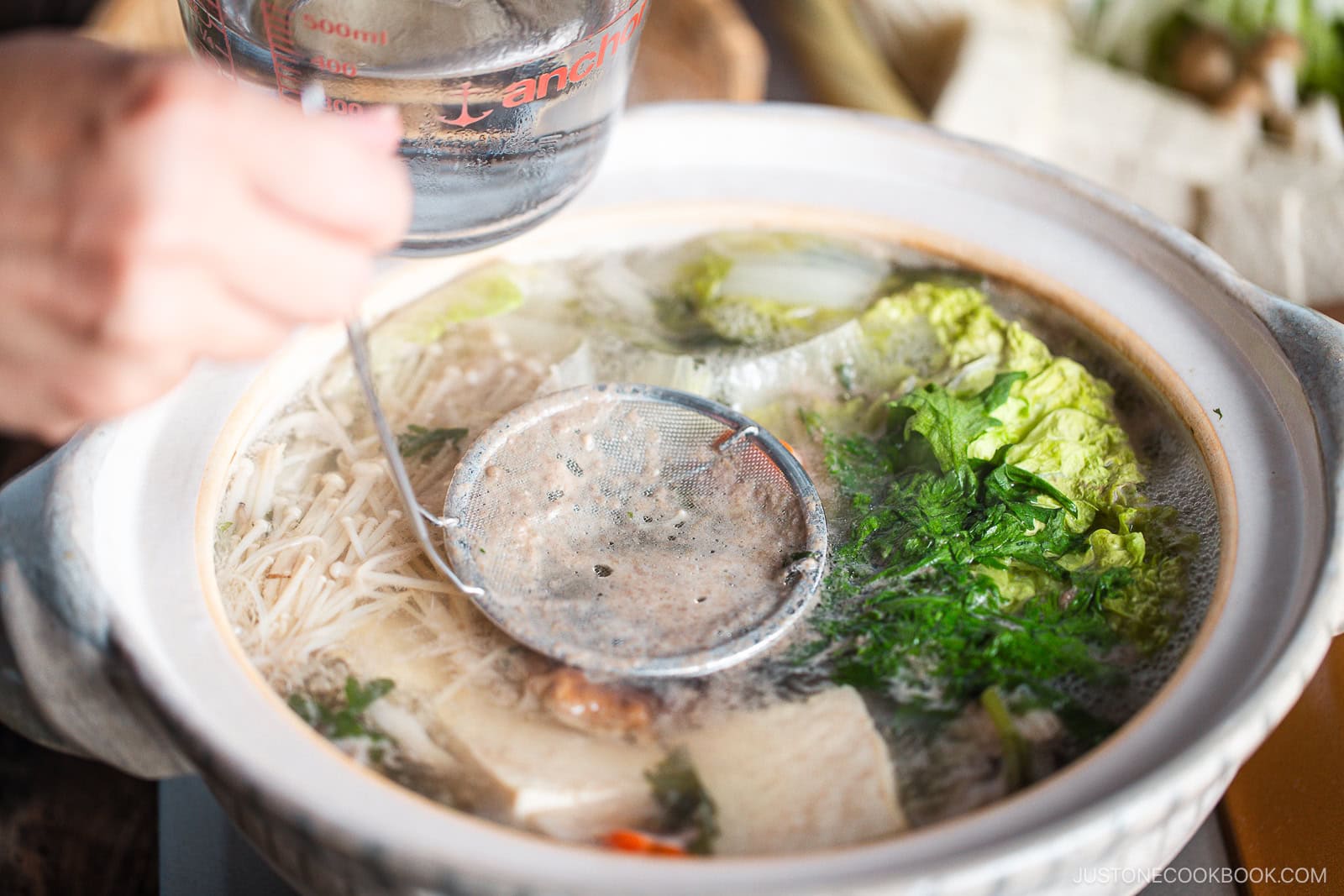
Step 9 – Make the udon finishing course. After the main course of the meal, heat the noodles and serve in the bowls of ponzu sauce diluted with shabu shabu broth.
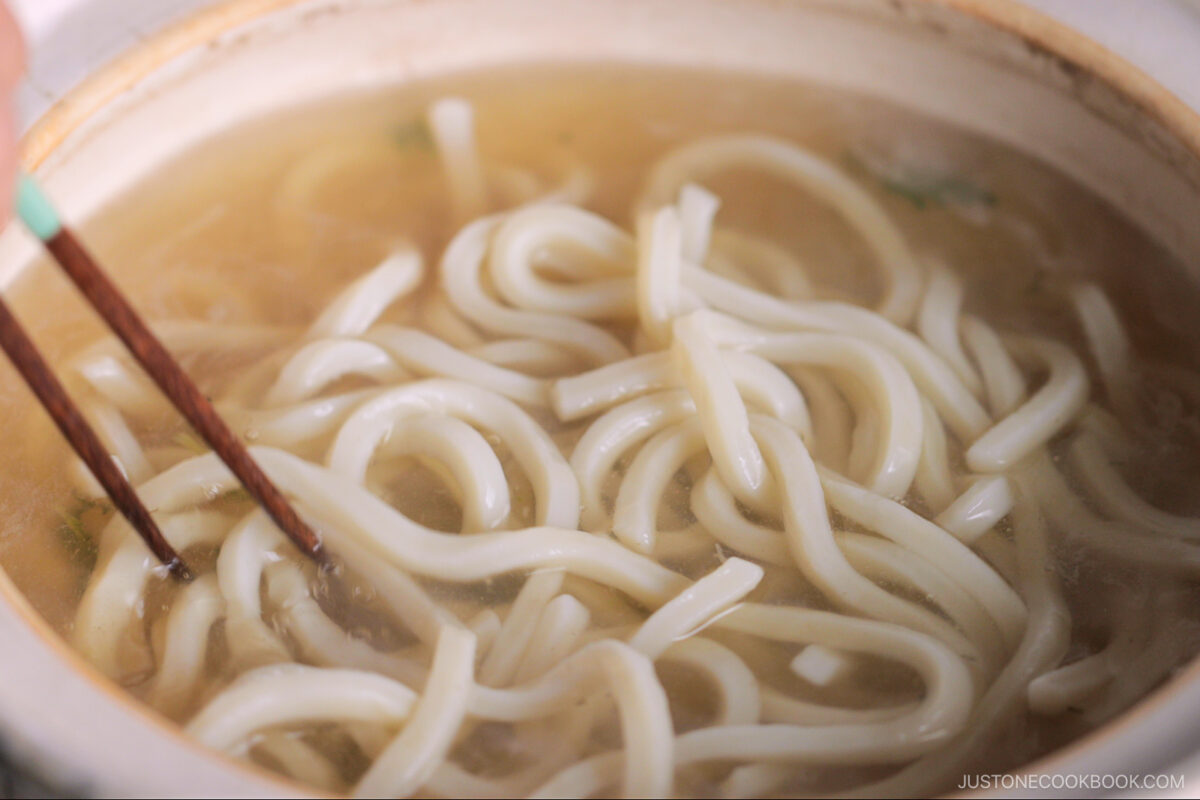
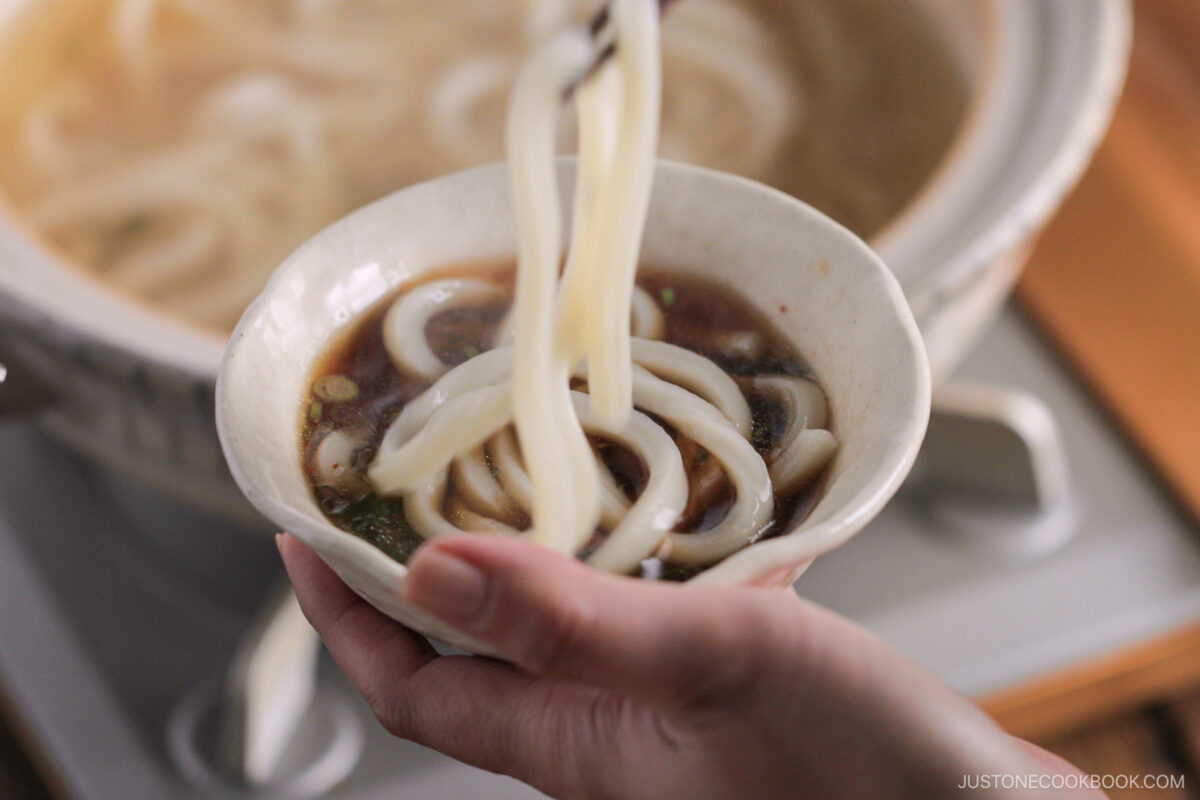
Nami’s Recipe Tips
- Use a pot that retains heat – We use a Japanese earthenware pot called donabe (土鍋) that distributes and retains heat well. You could also use a heavy-bottomed pot or an electric hot pot.
- Use paperthin meat – The well-marbled beef adds flavor to the broth and the thin slices take seconds to cook. Simply swish the slices in the broth with cooking chopsticks and be careful not to overcook it.
- Prep all the ingredients beforehand – Cooking goes quickly, so make sure everything is ready to go before you start.
- Cook the food in order – Start cooking the dense vegetables first until tender, then briefly swish the thin-sliced beef in the hot broth and serve. Add the soft leafy vegetables afterwards and cook until tender.
- Pick one person to cook the meat – This way, everyone gets meat at the same time. They can serve directly to the individual bowls around the table as each piece is done cooking.
- Clean the broth as you cook – Skim off the scum and foam from the surface with a fine-mesh skimmer to keep the broth as clean as possible.
- Cook in batches – If your cooking vessel can’t fit everything, cook a first round with a portion of the ingredients. Then, cook another round as you eat and make more room in the pot.
Variations and Customizations
- Use other proteins. We typically cook hot pot with thinly sliced beef and pork, but occasionally, we cook seafood or chicken as in my Chicken Hot Pot called Mizutaki.
- Add different vegetables. Try cabbage, broccoli, zucchini, carrots, other leafy Asian greens, and sweet corn (cut in sections).
- Use rice for the finishing course. Instead of udon, add cooked Japanese rice to make a porridge with the flavorful broth. Stir in beaten eggs to add extra substance and protein.
- Make it vegan/vegetarian. Simply omit the meat. The dashi, tofu, udon, and dipping sauces are all plant-based shabu shabu ingredients. For greater variety, I suggest adding a mixture of tofu, such as grilled tofu or tofu puffs.
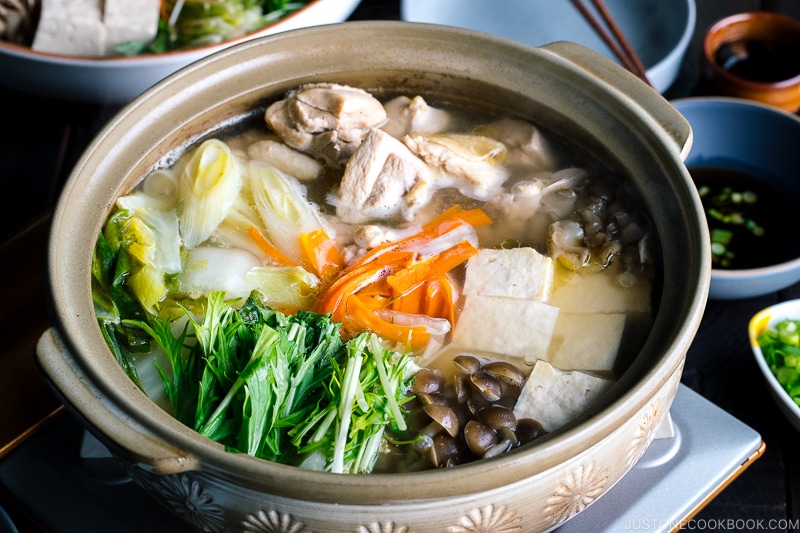
Storage Tips
To store: You can keep the leftovers in an airtight container and store in the refrigerator for 3 days or in the freezer for a month.
Shabu Shabu
Ingredients
- 1 piece kombu (dried kelp) (1 piece per large donabe; 10 g, 3 x 3 inches, 7.5 x 7.5 cm per piece)
- water
- 1 serving udon noodles (8.8 oz, 250 g frozen or parboiled udon noodles; 3 oz, 90 g dry udon noodles)
- 8 leaves napa cabbage (12 oz, 340 g)
- ½ bunch shungiku (chrysanthemum greens) (4 oz, 113 g)
- 1 Tokyo negi (naga negi; long green onion) (white part only; 4 oz, 113 g; or use 1 leek or 2 green onions)
- 1 package enoki mushrooms (7 oz, 200 g)
- 1 package shimeji (brown beech) mushrooms (3.5 oz, 100 g)
- 4 shiitake mushrooms (2.3 oz, 65 g)
- 2 inches carrot (2.3 oz, 65 g)
- 1 package medium-firm tofu (momen dofu) (14 oz, 396 g)
- 1 lb thinly sliced beef (such as ribeye) (4–5 oz, 113–140 g per serving)
For the Sauces and Garnish
- ponzu (store bought or make my Homemade Ponzu Sauce)
- sesame dipping sauce (store bought or make my Homemade Sesame Sauce)
- 2 inches daikon radish (5 oz, 143 g)
- 2 green onions/scallions (0.9 oz, 25 g)
- shichimi togarashi (Japanese seven spice) (optional, for a spicy kick)
Instructions
Before You Start…
- You can make my Homemade Ponzu Sauce and Homemade Sesame Sauce from scratch ahead of time. You can also purchase these sauces at Japanese grocery stores.
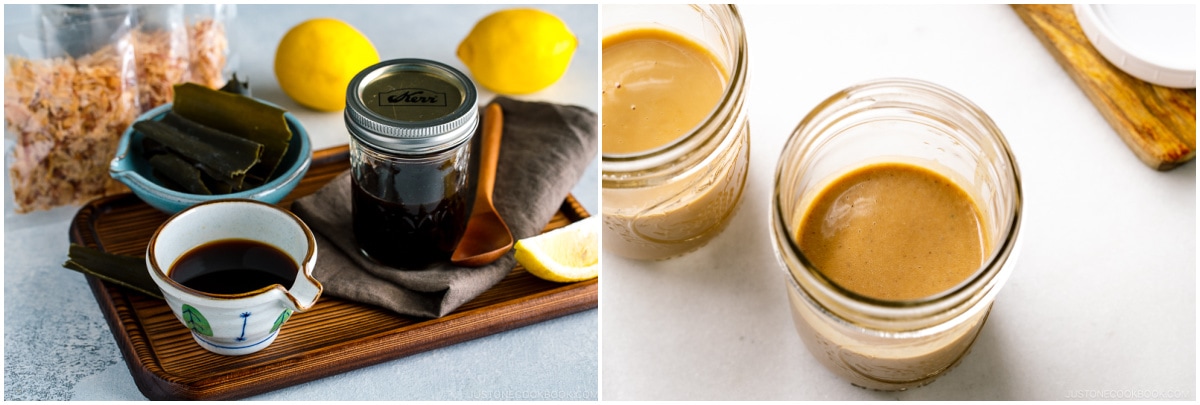
- Gather all the ingredients.
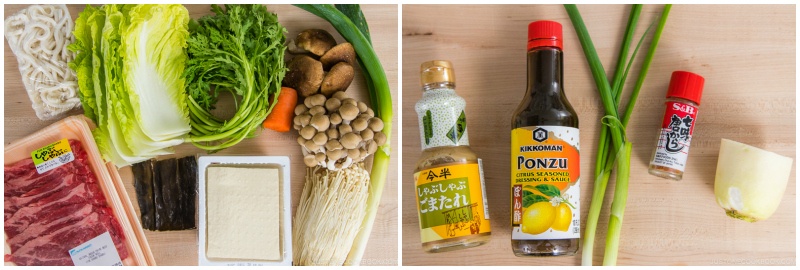
To Prepare the Stock
- Fill 1 large donabe clay pot (or Dutch oven or any heavy-bottomed pot) two-thirds full of water. Add 1 piece kombu (dried kelp) and soak for at least 30 minutes. Meanwhile, prepare the other ingredients. The right image shows the kombu dashi after 30 minutes. Note: Use 1 piece of kombu per large donabe. If you‘re doubling this recipe, use two donabe and put 1 piece of kombu in each pot.
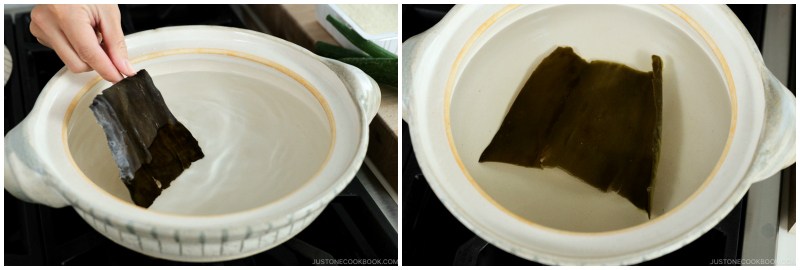
To Prepare the Hot Pot Ingredients
- Prepare the udon noodles according to the package instructions. I use 1 serving udon noodles (still frozen) and reheat it in boiling water for 1 minute. Transfer them to iced water to stop the cooking, then drain well. Place on a plate and set aside. The meal ends with the udon course after you‘ve eaten the main meal.

- Cut 8 leaves napa cabbage crosswise into 2-inch (5-cm) pieces, and then cut each piece in half or thirds lengthwise. Keep the tough/thick parts and leafy pieces in separate piles.
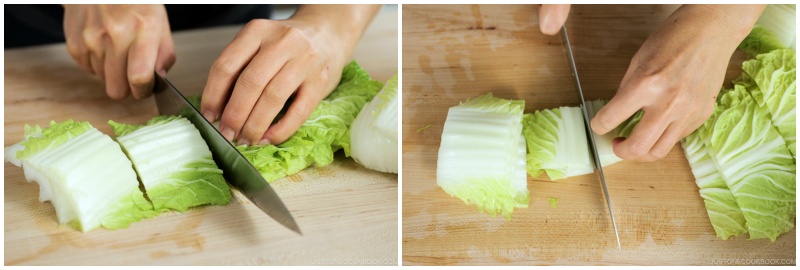
- Cut ½ bunch shungiku (chrysanthemum greens) into 2-inch (5-cm) pieces. Keep the thick parts and leafy pieces in separate piles.
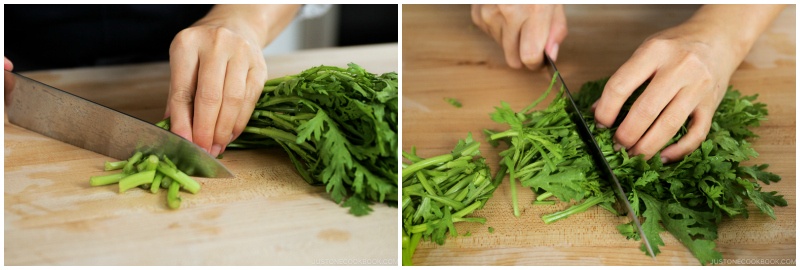
- Diagonally cut only the white part of 1 Tokyo negi (naga negi; long green onion) into pieces ½ inch (1.3 cm) thick. Tip: Reserve the green part for another use, like making Homemade Chashu.
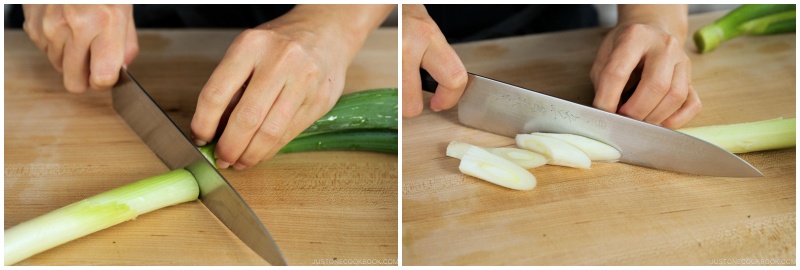
- Rinse 1 package enoki mushrooms and 1 package shimeji (brown beech) mushrooms. Discard the root ends of both mushrooms and separate them into smaller chunks.

- Cut off the stems of 4 shiitake mushrooms. Optionally, cut a decorative flower pattern on the caps (see How to Cut Shiitake Hanagiri).

- Cut 2 inches carrot into ¼-inch rounds. Optionally, you can use a vegetable cutter to cut the carrots into a flower shape.

- Cut 1 package medium-firm tofu (momen dofu) into square pieces about 1 inch (2.5 cm) thick.
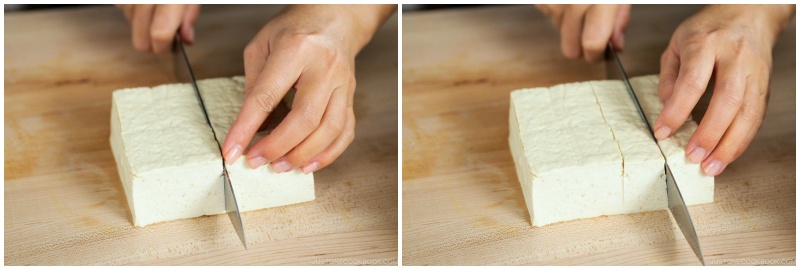
- Arrange all the vegetables, mushrooms, and tofu on a serving platter.
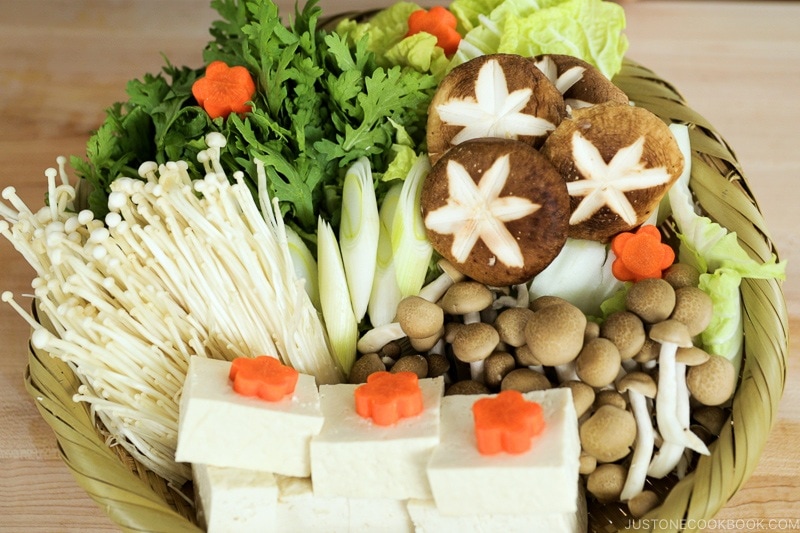
To Prepare the Garnishes and Beef
- Peel 2 inches daikon radish and grate it (I use a ceramic grater). Squeeze it gently to remove most of the liquid and put the grated daikon in a small bowl.
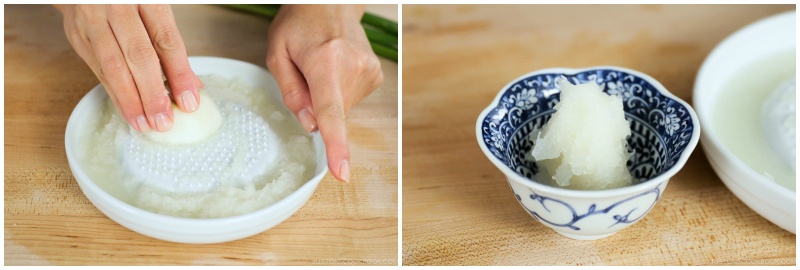
- Cut 2 green onions/scallions into thin rounds and put it in a bowl.
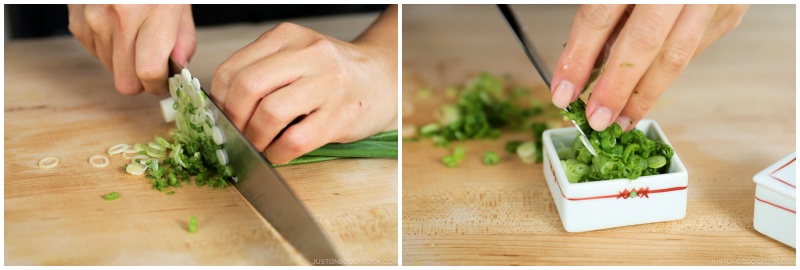
- Prepare optional shichimi togarashi (Japanese seven spice) in a bowl. Lay the 1 lb thinly sliced beef (such as ribeye) on a platter.
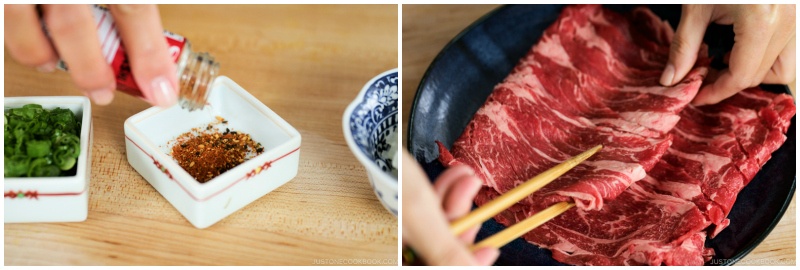
To Cook the Shabu Shabu
- Set up a portable gas stove at the table and put the donabe on the burner. Place the platters with the ingredients on the table. Give each person their own bowls of ponzu and sesame dipping sauce. I also prepare a shallow bowl for each diner to cool their food.
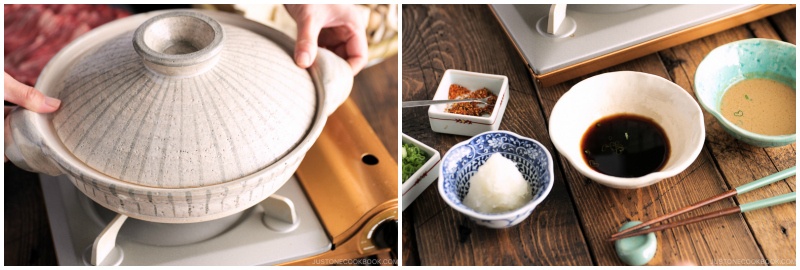
- Bring the broth to a simmer over medium heat. Take out the kombu right before water starts to boil (otherwise, the water will get slimy).
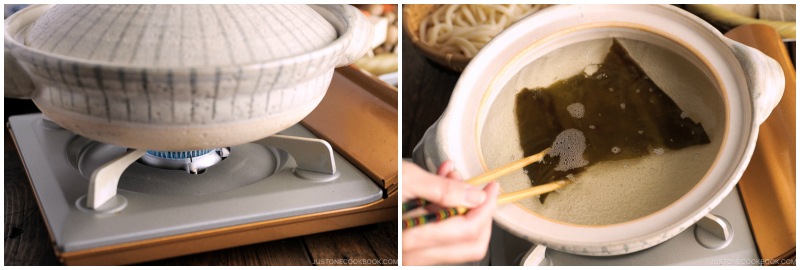
- Add the tofu, tough parts of napa cabbage and shungiku, negi, carrots, and some mushrooms. Reserve the softer, leafy vegetables to cook later. You don’t have to put all the ingredients in at once; cook in batches, if you prefer. Cover to cook for 10 minutes.
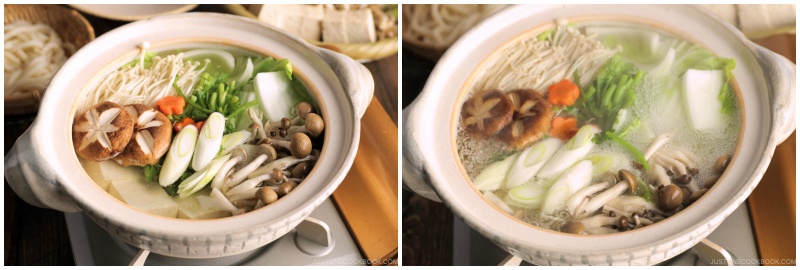
To Eat the Shabu Shabu
- While you’re waiting for the food to cook, prepare your dipping sauces. Add the grated daikon, shichimi togarashi, and green onion to the ponzu. Add the green onion to the sesame sauce.

- When you‘re ready to eat the meat, pick up a piece of thinly sliced beef with a set of communal cooking chopsticks. Stir or “swish“ the meat in the boiling broth and cook for 20–30 seconds or until the meat is no longer pink; be careful not to overcook it.
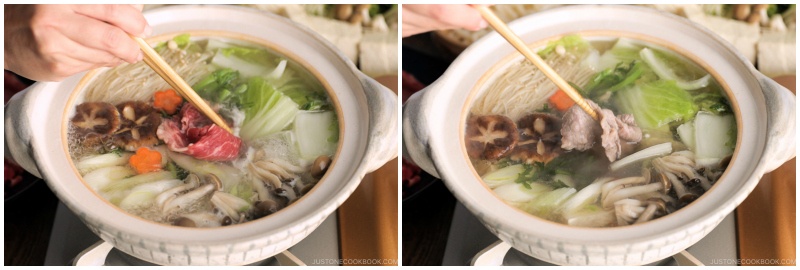
- Serve the beef, vegetables, mushrooms, and tofu once cooked and enjoy the food dipped in ponzu or sesame sauce.
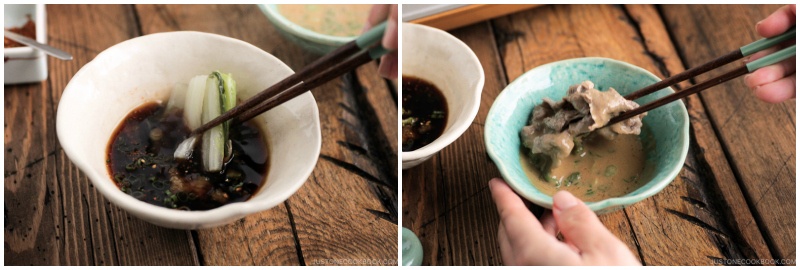
- Skim off the scum and foam from the surface, especially after cooking the meat, to keep the broth as clean as possible. Then, add the softer, leafy vegetables to the broth as you make room in the pot. Simmer for a few minutes and serve. Cook the meat as you're ready to eat, and enjoy the other ingredients while restocking the pot along the way.Tip: Prepare a fine-mesh skimmer and a 2-cup measuring cup filled with water so you can easily skim as you cook at the table. The water will help clean the skimmer.
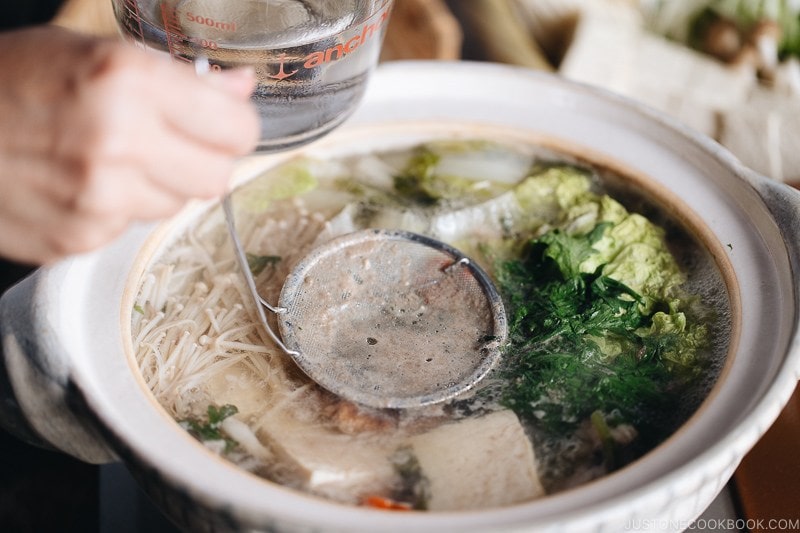
To Make the Udon Course
- When you're done cooking the ingredients, skim the broth one last time to prepare for the udon noodles. Typically, a hot pot meal ends with cooking udon noodles or porridge.
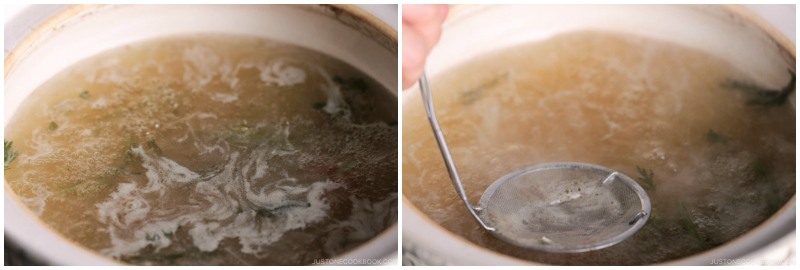
- Add the udon noodles to the pot and reheat for 1–2 minutes. Lightly season the broth with salt and white pepper, if you‘d like (optional).
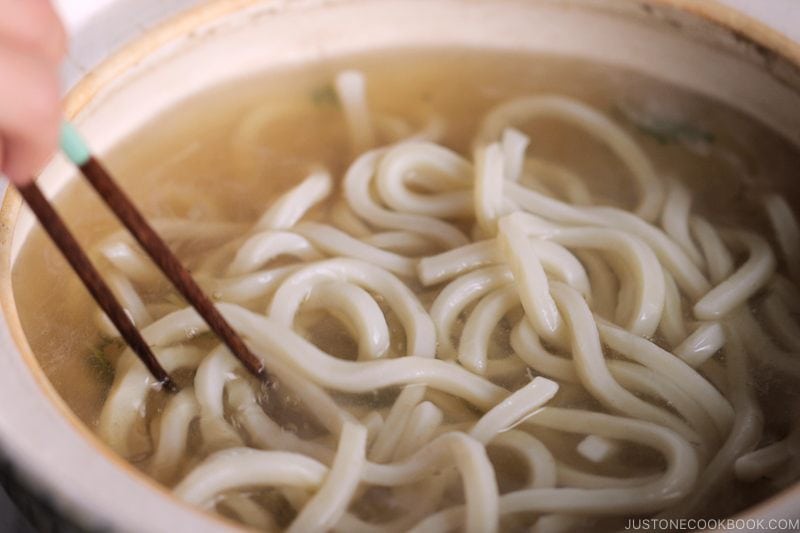
- Dilute the individual bowls of ponzu sauce with the broth and serve the udon noodles in each bowl.
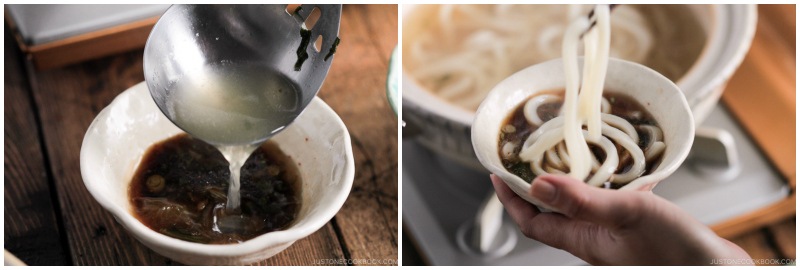
To Store
- You can keep the leftovers in an airtight container and store in the refrigerator for 3 days or in the freezer for a month.
Nutrition
Did you make this recipe?
Tag @justonecookbook on Instagram so we can see your delicious creation!
Editor’s Note: This post was originally published on December 2, 2011. It was updated with a new video and new images in December 2018. It was republished with more helpful content on April 11, 2025.



